Civilisations Collection THE ROMANS
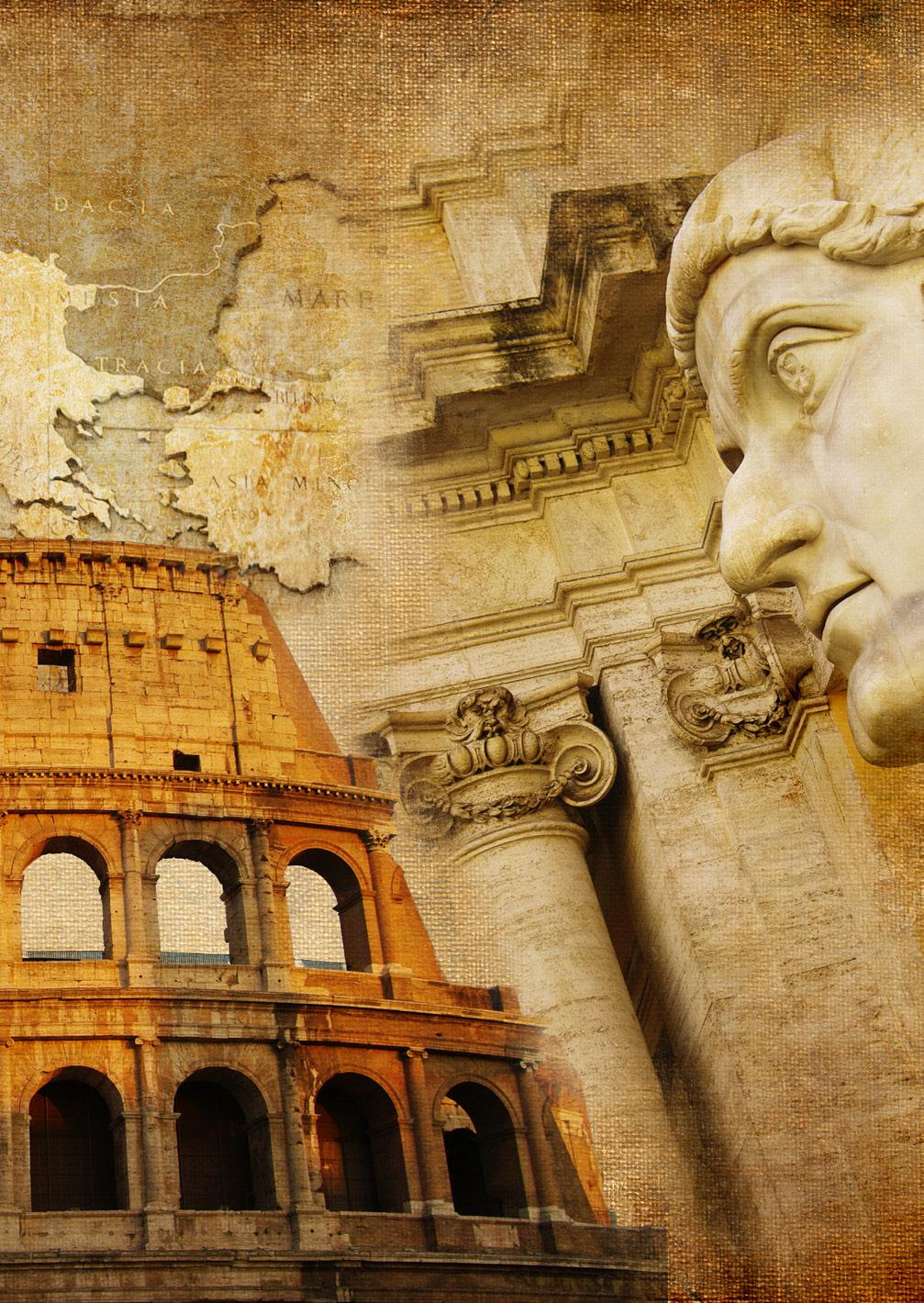
A COLLECTION OF TOURS EXPLORING THE REACH AND INFLUENCES OF THE EXTENSIVE ROMAN EMPIRE


A COLLECTION OF TOURS EXPLORING THE REACH AND INFLUENCES OF THE EXTENSIVE ROMAN EMPIRE


| THE VILLAGE THAT BECAME AN EMPIRE… |
Few civilisations have left a legacy as enduring, as visible, and as profoundly influential as that of Rome. This collection of specialist programmes invites you to explore that vast inheritance and discover the physical and cultural traces of the Roman Empire, which continue to shape the landscapes we move through and the histories we tell.
In Italy, we begin at the heart of the mighty empire. Our itineraries here reveal the splendours of Rome itself – the huge forums, imperial monuments, and intimate domestic spaces that speak to the city’s long continuum of life – and extend to the shores of Campania and the extraordinary sites preserved by Vesuvius, where recent excavations continue to unveil remarkable new discoveries. Across the straits in Sicily, we discover how Roman ambition overcame older Phoenician and Greek cultures. Beyond Italy's borders, the story of Rome unfolds across continents. In Tunisia, witness the legacy of the Punic Wars at Carthage before travelling through a landscape dotted with superbly preserved Roman cities, from the magnificent amphitheatre at El Djem to the remote splendour of Dougga. In southern France, Roman Provence reveals some of Europe's most unspoiled ancient monuments, including the majestic theatre at Orange and the engineering triumph of the Pont du Gard. Journey to Germany's Rhine frontier to explore the limes Germanicus, where Rome drew its northern boundary, or travel east to Jordan, where the dramatic city of Jerash showcases Roman urbanism at its finest.
This is a great time for Roman archaeology. New excavations are transforming our understanding of sites we thought we knew well, while advances in technology allow us to peer beneath ancient streets and behind painted walls. Museums are being reimagined, previously inaccessible sites are opening their doors, and each season brings fresh revelations that rewrite the textbooks.
Each tour is led by expert archaeologists and historians who bring scholarly insight and infectious enthusiasm to every site. Whether you're standing before newly opened sections of Pompeii's Regio V, admiring the gladiatorial mosaic at Germany's Villa Nennig, or watching the sun set over Petra's rose-red temples, our specialists will illuminate the context, the controversies, and the human stories behind these ancient stones.
We look forward to welcoming you on one of our tours soon.
Mary Reynolds Head of Product
2026 SPECIAL OFFER –SAVE up to £375pp*
Enjoy savings of up to £375* per person when you book a tour featured in this brochure. Offer ends 14th November 2025
TERMS & CONDITIONS:
If you pay in full when you call to book your tour you can take advantage of a 10% discount.
We have negotiated over 250 places on a selection of our tours in 2026 with £0 single supplement.
2026 SPECIAL OFFER: Savings apply to new bookings on any tour departing in 2026 and cannot be used in conjunction with any customer holiday vouchers or credit notes, or any other offers, except for if a tour has any £0 single supplement places available. Any offers/discounts can be withdrawn at any time. Prices have already been reduced in this brochure and on our website. *The price reduction of £335pp applies to our Roman Germany tour departing on 27th September 2026, page 23.
PAY IN FULL: The larger saving of 10% on 2026 tours can be applied if pay in full at the time of booking. It is not available via our websites so, please call our Sales team who will calculate this saving for you. This offer is not combinable with the price reductions already in place on each tour but instead of.
£0 SINGLE SUPPLEMENT PLACES: There are a limited number of £0 single supplement places on selected departures. These places are also subject to hotel availability. This discount can only be combined with the other offers detailed on this page.
If you are interested in joining one of our tours and want to know more, please do give our Specialist Travel Executives a call today. They are ready to help with all of your questions.

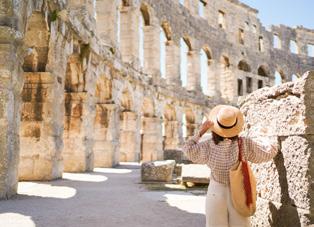
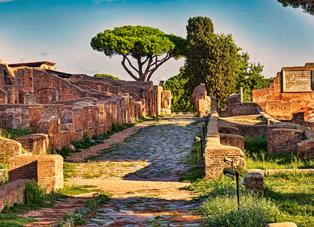
Our Guide Lecturers make an Andante tour a cut above the rest. Guests who travel with us frequently tell us that it is not only the high quality of guiding they receive but also the informality and ease of travelling with an Andante lecturer which keeps them coming back. Many of our Guide Lecturers are specialists in the Roman Empire, such as Tony O’Connor, an archaeologist with extensive field experience: "An Andante tour is special. Travelling with those who have a genuine interest in the past means travelling with a ready-made group of friends. Sharing knowledge of the sites I know and love so well is a joy amongst such company.
I’ve had a wonderful time on tour with Andante. I returned to Tunisia where I spent two weeks enjoying a plethora of stunning Roman mosaics, spectacular Roman ruins and the stunning landscapes of the Sahara with my fellow Andante travellers. In the spring, I went to my perennial favourite, Pompeii. On site we enjoyed the newly opened insula of the chaste lovers where the houses and bakery are still being excavated and at the Hotel Scapolatiello, we enjoyed several pre-dinner Negronis while watching the sun go down.
Autumn is always a wonderful time to travel too – admiring the sites in the longer shadows and evening glow that comes early in October and November, with spectacular sites blissfully devoid of tourists.
In 2026, I am thrilled to be joining Pompeii, Herculaneum & Classical Campania (p6), Classical Sicily (p16), The Romans in Algeria (p24), Carthage to the Sands of the Sahara (p30), Carthage & Roman Tunisia (p34) and look forward to discovering Roman treasures together."
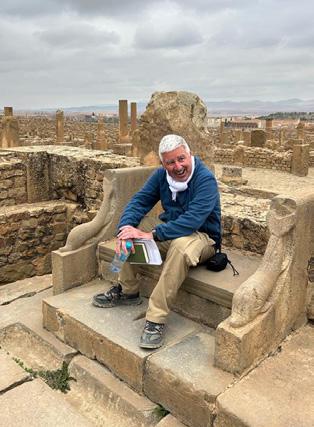
Unearth history's treasures with Andante, the pioneering British specialist on in-depth archaeological travels. Venturing beyond mere cultural excursions, we craft extraordinary journeys, granting you access to the world's most significant historical sites. With 24-hour support from our dedicated team and meticulously planned itineraries, rely on Andante for an unparalleled odyssey into antiquity.
No stone is left unturned to ensure you receive the most inclusive holiday
We make sure that we have included as much as possible in the cost of your holiday, from group flights and transfers, guides and entrance fees to tips for local staff, domestic flights and, on most of our tours, all meals.
Quality time on site – we don’t cut corners
When you choose an Andante archaeological tour, rest assured that your time at sites will be well spent. We don’t cut corners, you won’t be rushed and your visits will be at a pace that independent travellers aim for when exploring the ancient world.
Programmes that follow a theme
Our itineraries are designed by experts and led by them, which means our tours remain engaging and invigorating. Our programmes are diverse and exciting, with each itinerary delving into the stories of a particular era or civilisation.
Insider Knowledge
We know the destinations and sites we visit inside and out, including the best way to get you there, enabling us to create the most in-depth and immersive tours possible.

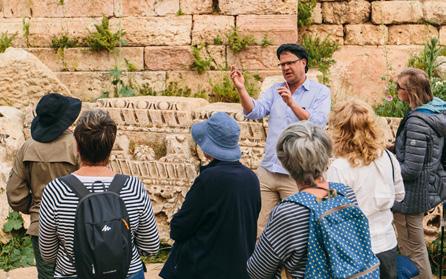
753 BC ROME IS FOUNDED BY TWIN BROTHERS ROMULUS AND REMUS
264-146 BC THE PUNIC WARS OCCUR BETWEEN ROME AND CARTHAGE
509 BC ROME OVERTHROWS THE ETRUSCAN EMPIRE AND THE ROMAN REPUBLIC IS FORMED

Small Groups mean more attention
Most of our tours are limited to 18 guests, meaning that you get the chance to get up close and personal to those things you’ve only ever read about or seen on film.
The best Guide Lecturers, Tour Managers and Local Guides
Every tour with Andante Travels is accompanied by a Guide Lecturer and a Tour Manager. Often you will be further joined by a local guide who adds an element of local flavour to the expertise of your Guide Lecturer. This means that you are never short of someone who will help you satisfy your curiosity.
Keeping close to our sites
All our accommodation is carefully chosen to help you get the most out of your tour. Location is key as we want to be close to the sites we visit and keep travelling between them to a minimum.
Dine with us
We have made sure that many of your meals are included in the cost. Dinner is often taken at a local restaurant and most evening meals include wine.
And the essentials…
Of course, all your group flights to and from the UK are included as well as all overseas group transfers.
Your accommodation costs are all included in the price of your holiday, however, if you do fancy that extra bit of luxury, do contact us and we will be pleased to advise on room upgrades.

49 BC JULIUS CEASAR BECOMES DICTATOR OF ROME
131 BC ROME CONTROLS COASTAL SPAIN, FRANCE, GREECE, TURKEY AND NORTH AFRICA
44-27 BC UNREST IN ROME LEADS TO THE TOPPLING OF THE ROMAN REPUBLIC
44 BC JULIUS CAESAR IS ASSASSINATED BY A GROUP OF SENATORS
27 BC THE ROMAN EMPIRE IS OFFICIALLY FOUNDED
| LASTING OVER A THOUSAND YEARS, THIS ANCIENT CIVILISATION CONTINUES TO SHAPE AND INSPIRE THE MODERN WORLD |

The proverb ‘all roads lead to Rome’ originated from the intricate network of roads built by the Roman Empire. This saying reflects the idea that many different paths or methods can lead to the same goal. During the height of the Roman Empire, the city of Rome was the centre of civilisation, and the extensive system of roads connected the far reaches of the empire to its capital. These roads were crucial for military movements, trade and communication, making Rome accessible from various directions. But who were these Romans that built such a network of roads that linked trade and commerce from country to country? And why is their legacy still seen today in various aspects of modern society, from government and law to architecture and engineering?
The Romans are renowned for their vast empire, which at its peak encompassed much of Europe, North Africa and parts of the Middle East. The Roman Empire was known for its advanced engineering, architecture, legal system and military prowess. Romans contributed significantly to the development of Western culture, including the Latin language, which evolved into the Romance languages.
A lifestyle and culture that stands the test of time
The ancient Roman lifestyle was a fascinating blend of practicality and indulgence. Romans placed great importance on family, social status and public life and their homes ranged from modest apartments to grand villas, reflecting the social status of the inhabitants. We can see remains of some of the grandest villas on Romans on the Bay of Naples in the picturesque town of Positano on the Amalfi coast.
Culture in ancient Rome was heavily influenced by the Greeks, particularly in the realms of art, literature and philosophy. Romans were great patrons of the arts, and their contributions included intricate mosaics, sculptures and frescoes that adorned public buildings and private homes.
Leisure activities, feasting and entertainment were an essential part of Roman life. If you’ve ever wondered what a Roman dinner was like, imagine the sophisticated conversation, recitations of poetry and gentle music performed by a flute. However, some gatherings were just as likely to involve raucous drinking, naked tightrope walkers and vulgar ostentation. Traditionally thrown in the early evening, after a visit to the baths and an afternoon of fun and games, the Roman dinner party was one of the most important pieces of social and political cement in the Republic and Empire. Indeed, public baths, known as thermae, were popular places for socialising, relaxation and exercise. The Romans also enjoyed attending theatrical performances, gladiatorial games and chariot races. Most people are familiar with the film Ben Hur and the epic chariot race scene with Charlton Heston. These types of events were held in grand arenas like the Colosseum and the Circus Maximus – part of the Rome
tour, drawing large crowds and providing entertainment for all social classes.
Roman art was diverse and prolific, encompassing various forms such as painting, sculpture and architecture. Public art was often used to celebrate military victories and honour gods and emperors. The Romans were skilled engineers and architects, as evidenced by their impressive aqueducts, roads, and monumental structures like the Pantheon and the Roman Forum.
Private art, found in homes and villas, often depicted scenes of daily life, mythology, and nature, showcasing the Romans' appreciation for beauty and craftsmanship.
The path to military (and road) expansion is the Roman legion
The Roman path to military growth was marked by strategic alliances, disciplined armies and innovative tactics. Initially, Rome's military efforts were focused on defending its territory against neighbouring tribes.
However, as Rome grew in power, it began to adopt a more aggressive stance, seeking to expand its influence across the Italian peninsula and beyond.
The Roman legions, known for their rigorous training and strict discipline, played a crucial role in these conquests. Moreover, Rome's ability to integrate conquered peoples into its society helped to stabilize and secure its growing empire. The use of engineering and logistics, such as the construction of roads and fortifications, further facilitated the movement and supply of Roman troops, enabling them to maintain their dominance over vast territories.
Key periods of expansion include the Punic Wars, where Rome defeated Carthage and gained control over the western Mediterranean, and the conquests of Julius Caesar, which extended Roman territory into Gaul (modern-day France).
Eventually, the roads that paved the way to Rome would be responsible for its destruction. Military unrest and invading forces alongside political strife all contributed to the fall of the empire. The city of Rome was sacked by German tribes and was ultimately destroyed when the last Roman emperor, Romulus Augustulus, was deposed by the Germanic king Odoacer.
All roads lead to the legacy of the Roman Empire
Andante Travels presents the opportunity to trace the history of the Roman Empire across continents, back to Rome itself. We invite you to discover for yourself what the Romans left behind that can be found in the Temples, ruins, relics, villas, fortifications and roads across Europe and West Africa.
Evidence of Roman Civilisation is all around us and with the help of our expert guides, the ancient past can be discovered today.

14 AD AUGUSTUS, THE FIRST ROMAN EMPEROR DIES
43 AD THE ROMANS INVADE BRITAIN UNDER EMPEROR CLAUDIUS
72-80 AD THE ROMAN COLOSSEUM IS CONSTRUCTED
79 AD MOUNT VESUVIUS ERUPTS AND BURIES MULTIPLE TOWNS
98-117 AD ROME AND THE EMPIRE PEAKS UNDER EMPEROR TRAJAN
122 AD HADRIAN’S WALL IS BUILT AS THE NORTH-WEST EMPIRE FRONTIER
306 AD CONSTANTINE BECOMES THE FIRST CHRISTIAN EMPEROR
476 AD GERMANIC TROOPS STORM ROME AND THE EMPIRE COLLAPSES
395 AD ROME SPLITS INTO TWO SEPARATE STATES, EAST AND WEST
476-900 AD THE FALL OF THE ROMAN EMPIRE IS FOLLOWED BY THE DARK AGES
Visit newly excavated houses in Pompeii 8 days from £2,655pp

Nowhere in the world gives deeper insight into Roman life than the dramatic towns of Pompeii and Herculaneum. Before the cataclysmic eruption of Vesuvius these were thriving, lively seaside towns that have since been frozen in time.
Pompeii was once a centre for trade, equipped with many bars, shops and brothels, while neighbouring Herculaneum was an affluent and elegant town. All this came to an abrupt halt, however, one autumnal day in AD 79, when Vesuvius, which had done little more than rumble for years, erupted with incredible force.
Two thousand years later, the sites of the Bay of Naples confront the modern visitor with a vivid, haunting immediacy like nothing else in the ancient world. In some cases, we even know the names, professions and personal histories of the people who owned the villas and shops we visit. The preservation of Herculaneum, Pompeii and its surrounding sites is remarkable, and the archaeology is beyond compare, which is why we have been leading tours here for over 30 years. This is, however, perhaps the most exciting time for visitors as discoveries are being made and new houses opened. Take the chance to journey back in time, to walk with us as the Romans did, from amphitheatres and baths to forums, as our Guide Lecturer conjures an evocative picture of the everyday life of these prosperous Roman towns.
Dr Eireann Marshall | Join Eireann on our 16th February departure.
Dr Simon Elliott | Join Simon on our 9th March & 26th October departures.
John Shepherd | Join John on our 16th March, 27th April & 5th October departures.



Dr Doru Bogdan | Join Doru on our 13th April departure.

No other site compares in revealing details of daily life in a Roman town than Pompeii. Look forward to visiting some of the town’s most well-preserved buildings as well as an amphitheatre, theatre, forum, bathhouses, bars and even brothels. Keep an eye out for fountains in the street, worn from where countless people rested their hands to take a drink and the Roman graffiti which can still be seen on the walls. As part of the Great Pompeii Project, recent finds here include three skeletons, whose manner of death is as gruesome as the initial evidence might suggest but in a surprising way; a domus from the Samnite period, repurposed into a bakery, which has shown us a small detail about how the Pompeian’s were experts at reusing and recycling materials and seismological evidence that confirms to modern volcanologists the accuracy of the account written by the eye-witness Pliny the Younger for his friend and historian, Tacitus. Travelling via the best routes to avoid the crowds, we also visit some houses that are newly reopened to the public.
Dr Jamie Sewell | Join Jamie on our 4th May departure.

Dr Gillian Shepherd | Join Gillian on our 7th September departure.
Diana Blumberg | Join Diana on our 28th September departure.


Tony Wilmott | Join Tony on our 19th October departure.

YOUR TOUR ITINERARY
Day 1 - London - Naples - Cava de’ Tirreni
Day 2 - Paestum
Day 3 - Pompeii
Day 4 - Naples - Pozzuoli
Day 5 - Stabiae
Day 6 - Herculaneum - Boscoreale
Day 7 - Vesuvius - Oplontis
Day 8 - Cava de’ Tirreni - Naples - London


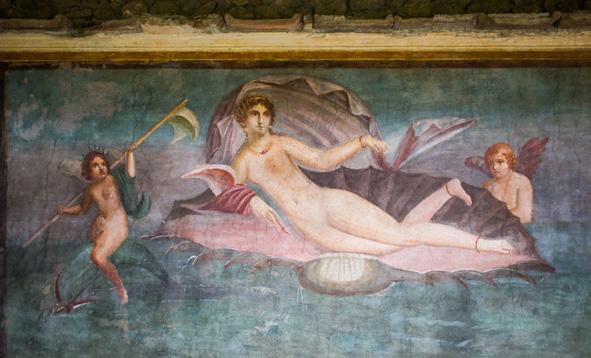
Go off the beaten track to the villas of Stabiae, an exclusive Roman resort for the very wealthy. The vast Villa San Marco, with its swimming pool and bath complex, is one of the most opulent along this coast and it remains very impressive in its scale. Subject to renovations being completed, we hope to visit the Villa Arianna, with its wonderful frescoes and fabulous views over the Bay of Naples. The Archaeological Museum of Castellammare di Stabia Libero D’Orsi awaits too, which opened in September 2020 specifically for the exhibition of the many important items found in the region of Stabia. There are a large number of finds on display, some never before exhibited in Italy, including frescoes, inlaid floors, stuccoes, sculptures, tableware and more.
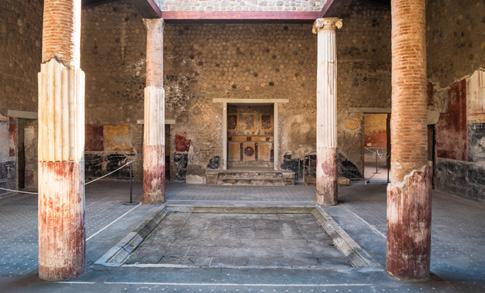
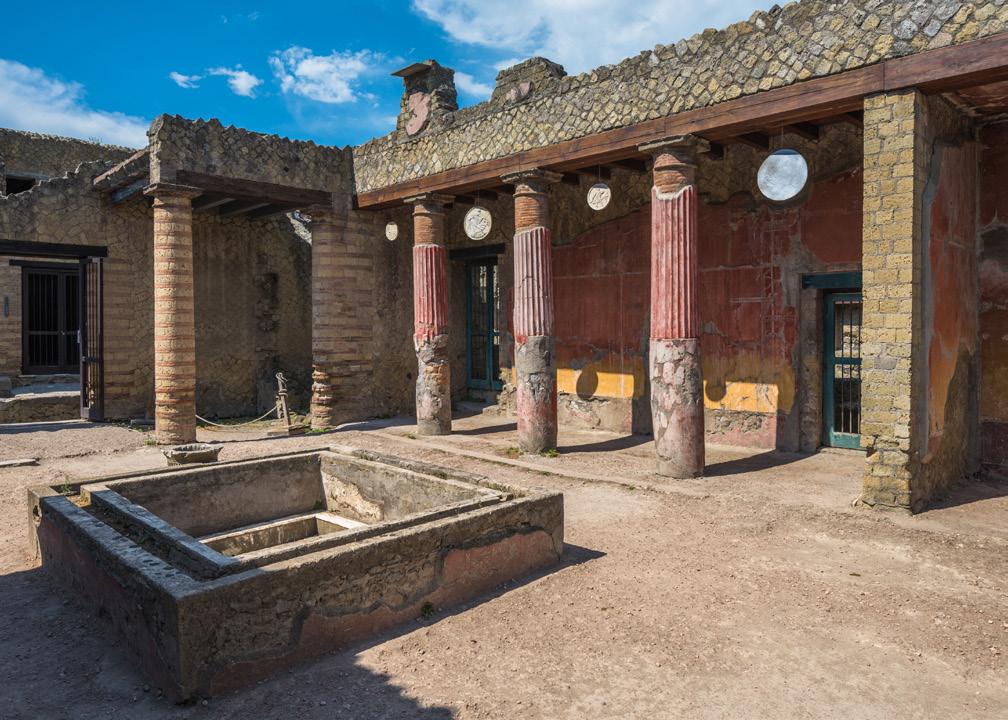

Fascinating Herculaneum, revealed in 1748, perfectly complements a visit to Pompeii. This seaside city was once a retreat for the Roman elite and was buried to a significantly greater depth than Pompeii – under 23 metres of pyroclastic to be exact – perfectly preserving everyday objects as well as houses up to their rooftops. Highlights include the House of Galba with its unique cross-shaped pool, the dolphin mosaic on the floor of the frigidarium at the well-intact baths, the colourful frescoes at Sacello degli Augustali, with one featuring Hercules, Juno and Minerva in Olympus, plus the series of shops, where dye pots, bronze baking pans and containers filled with walnuts and chickpeas were found. In addition to this expansive site, we explore the Antiquarium, newly opened after 44 years, which houses precious articles found along Herculaneum’s seafront, including a well-preserved boat, found alongside the remains of the residents attempting to escape the eruption. Other items from both public and private buildings range from objects of daily life to the statue of Marcus Nonius Balbus and beautiful frescoes found in the Villa of the Papyri.

Boscoreale is a locality north of Pompeii, located on the slopes of Vesuvius. Here we explore Villa Regina, discovered in the late 20th century while digging for the foundations of council housing. In contrast to the opulent villas in the nearby seaside towns, this is a modest small holding which provides us with intriguing evidence of how ordinary people lived. With the inauguration of the Great Pompeii, in October 2023, the Antiquarium of Boscoreale was reopened with a room dedicated to the excavations underway in the suburban villa of Civita Giuliana, with the ceremonial chariot found there in 2021.
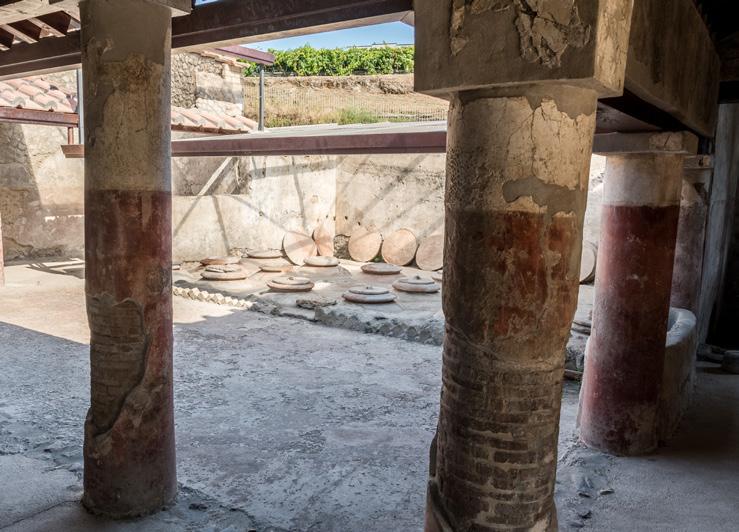
Ascending to the great volcanic crater of Vesuvius is no doubt one of the most memorable moments of this tour. The majority of our journey is by bus, but the final part requires walking (45 minutes), which is always well worth the effort and begins at Monte Somma, the crater of the AD 79 eruption. After the ascent and peering into the crater, forged since the ancient eruption, we see fumaroles and the layers of previous eruptions, while walking around the perimeter of the crater affords magnificent views over the Bay of Naples. On good days, you can even make out Pompeii! The highlights continue with the impressive villa at Oplontis, which boasts sumptuous frescoes of vibrant golds, reds and blues, a bath complex, an enormous swimming pool and interesting slave quarters. This villa was supposedly owned by Emperor Nero and was both destroyed and subsequently preserved by Vesuvius’ eruption, making it one of the most significant treasures of the Pompeii suburbs. It is easy to imagine how the villa once was, overlooking the sparkling seas with lavish decorations and paintings inside and olive groves, lemon trees, cypresses, roses, climbing ivy, sculptures and fountains adorning the gardens outside. Quieter than sites such as Pompeii, a visit here is like stumbling upon a hidden gem and is a fitting end to this wonderful tour.
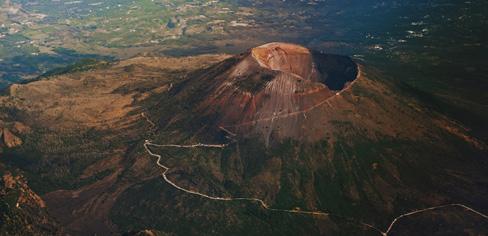

YOUR COMPREHENSIVE EXPERT GUIDED TOUR INCLUDES
Expert Guide Lecturer & Professional Tour Manager, entries to all sites as per the itinerary, field notes, all taxes & gratuities to local staff (drivers, waiters, site custodians)
Return flights from London Heathrow, private group transfers to/from the airport and hotel and all local transport aboard a private air-conditioned coach | 7 nights’ accommodation in the Hotel Forum (Feb) or Hotel Scapolatiello (Mar- Oct) | 7 breakfasts, 5 lunches & 7 dinners | Water with all meals, wine & tea or coffee with dinner
Dates & prices per person based on Twin/Dbl share
16th - 23rd Feb £2,830 £2,655
Single Supplement £335 £0
9th - 16th Mar £2,965 £2,780
Single Supplement £265 £0
16th - 23rd Mar £2,965 £2,780
Single Supplement £265
13th - 20th Apr £3,060 £2,870
Single Supplement £265 £0
27th Apr - 4th May £3,060 £2,870 Single Supplement £265 £0
4th - 11th May £3,170 £2,970
Single Supplement £265 £0
7th - 14th Sep £3,170 £2,970
Single Supplement £265 £0
28th Sep - 5th Oct £3,170 £2,970
Single Supplement £265 £0
5th - 12th Oct £3,170 £2,970
Single Supplement £265 £0
19th - 26th Oct £3,170 £2,970
Single Supplement £265 £0
26th Oct - 2nd Nov £3,170 £2,970
Single Supplement £265 £0
Save £200pp with our 2026 Special Offer
7 days from £3,680pp

Rome is one of the most charismatic and engaging of the great cities of the world, her monuments an omnipresent testament to a past in which she controlled an Empire reaching from Scotland to Syria. Surprisingly, it is also an intimate city - the historic centre is small, and it is easy to understand based on the ancient layout. This tour is the perfect introduction to the ‘Eternal City’ in the company of archaeologist and historians who will bring to life the triumphs, tragedies and political intrigue that characterised the Roman Empire. We stay at the Albergo Santa Chiara in the very heart of the ancient city, situated directly behind the Pantheon, the perfect base for exploring Rome. It has been privately owned by the Corteggiani family since 1838 and consequently retains a feel of personal warmth and friendliness.
Dr Jamie Sewell | An author of books and articles on the archaeology of towns in Hellenistic Italy, Jamie has 15 years’ worth of experience supervising excavations. Join Jamie on our 18th February departure.

John Shepherd | John has worked extensively in the field in Europe as an archaeologist, including France, Italy and Bulgaria. Join John on our 30th October departure.

Dr Simon Elliott | An award-winning and best-selling author, historian and broadcaster. Join Simon on our 24th April & 13th November departures.

YOUR TOUR ITINERARY
Day 1 - London - Rome
Day 2 - Forum & Colosseum
Day 3 - The Appian Way
Day 4 - Domus Aurea & Celian Hill
Day 5 - Tivoli
Day 6 - Field Of Mars & Ara Pacis
Day 7 - Ostia Antica - London
The shifting movements within art, entertainment, religion and politics are forever engraved on the Colosseum, the eternal city’s iconic amphitheatre, where gladiators once fought. The elliptical arena’s construction, carried out by 100,000 workers, began in 72 by Emperor Vespasian, who tore down the previous ruler Nero’s palace and ordered for the Colosseum to replace it, on a far grander scale. It became a fashionable place to enjoy entertainment –gladiator fights and executions attracted huge crowds. It even hosted mock sea battles, as they would seal up the holes and flood the entire lower area of the stadium, allowing mock naval battles to take place inside.
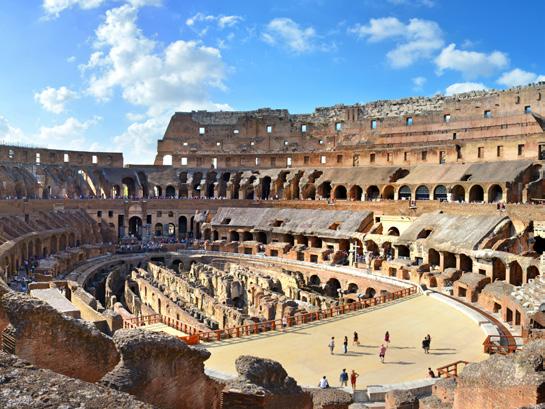
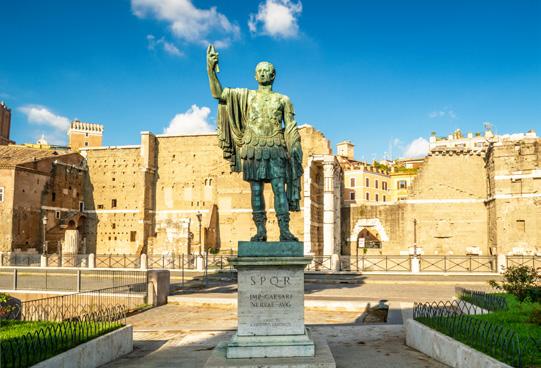
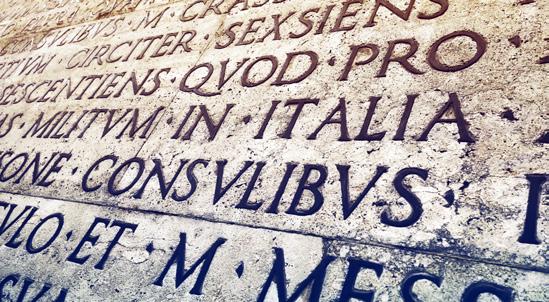

Offering a fascinating glimpse into this ancient civilisation, the Roman Forum is where the ruins of ancient Rome’s political and social centre can be found and is one of the most significant archaeological sites in the world. Once the heart of public life for the Romans, it hosted triumphal processions, elections, public speeches, trials and more. From the 7th century BC onwards, the forum soon became more than a bustling religious, administrative and legal hub and made increasingly grandiose by the Imperial period. Julius Caesar and Augustus made extensive renovations – marble paving and columns to showcase power, wealth and military success. Today, notable highlights include the Temple of Saturn, the Arch of Titus and the Basilica of Maxentius, while excavations are still ongoing to hopefully unearth new evidence about Rome’s exact age.
The Appian Way was used as the main route for military supplies to aid the conquest of southern Italy, connecting Rome to Capua and allowing the troops to move quickly across the Empire. One of the most strategically significant roads of the ancient republic, its construction began in 312 BC and was named after the Roman censor Appius Claudius Caecus. Stretching for over 350 miles, it remains a marvel of Roman ingenuity and even featured a sophisticated drainage system to prevent flooding. Surrounding it, in tranquil countryside, were the villas of the senatorial aristocracy, including the Villa of the Quintilii. This vast suburban estate was so sumptuous that the emperor Commodus executed its owners and confiscated it. The equally extensive Villa of Emperor Maxentius was built as a dynastic centre for his family. It includes the palace villa, a chariot racing circus and a large mausoleum. As of July 2024, the Appian Way was added to the UNESCO World Heritage List and offers other landmarks along the route, from baths and temples to mausoleums and tombs.

Emperor Nero built Domus Aurea, the Golden House, after the great fire of Rome, with the intention of creating a countryside in the city, and as such included artificial lakes, fountains, vineyards, as well as flocks. The megalomaniac building was eventually demolished by his successors and can now only be visited at certain times, in groups, where its ongoing restoration can be viewed. Caelian Hill is one of the famous seven hills of Rome and home to several ancient Roman houses known as the Domus Romane Del Celio, which date from the 2nd century. The site includes beautifully preserved frescoes and provides insights into the daily lives of its inhabitants.
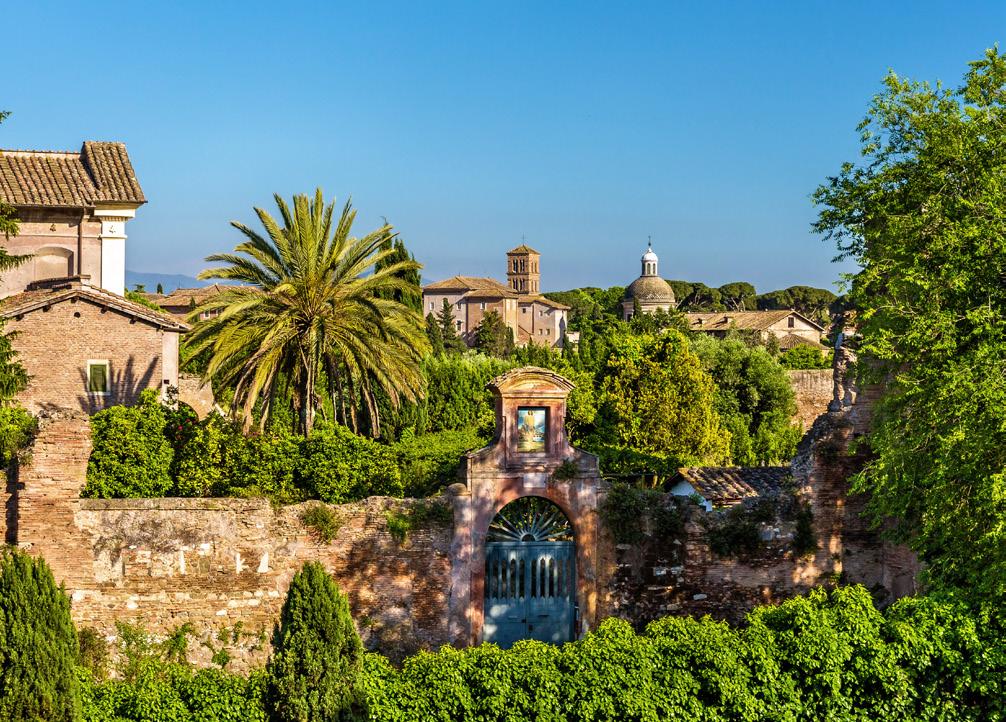

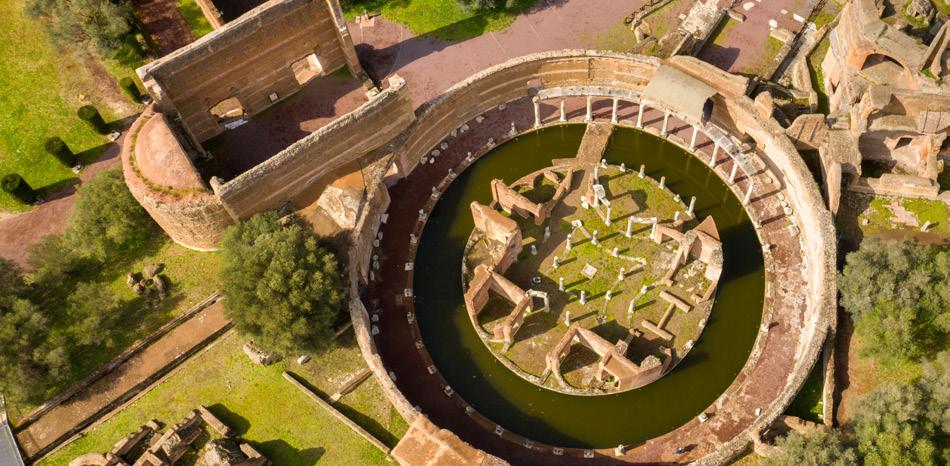
Tivoli is where Emperor Hadrian chose to build his palace, Hadrian’s Villa, which sprawls across the rolling countryside at the foot of the hills below the town of Tivoli. Beginning around AD 117 Hadrian took a small family villa owned by his wife and added on a whole series of grand pavilions, including temples, barracks, theatres, gardens and fountains, many of them modelled after places he had seen on his travels around the empire. The complex ended up larger than most Roman cities and has been listed as a UNESCO World Heritage Site since 1999.
The Romans considered water an element of high capital importance and the growing number of Roman imperial baths signified their growing power. Due to the abundance of sulphurous water in Tivoli, the baths were established here and deemed to have therapeutic properties.

| Ara Pacis |
Ara Pacis, a marble altar, was commissioned by the Roman Senate to honour the return of Augustus, after his campaigns in Spain and Gaul. The intricately carved alter serves as propaganda for Augustus, depicting the transition from the riotous times of civil war, the Roman Republic's chaotic era to a more peaceful era under Augustus, known as the 'Roman Peace.' The animation and individuality of the figures represent not only a change to calmer waters but also a growth in arts and culture during this time.

YOUR COMPREHENSIVE EXPERT GUIDED TOUR INCLUDES
Expert Guide Lecturer & Professional Tour Manager, entries to all sites as per the itinerary, field notes, all taxes & gratuities to local staff (drivers, waiters, site custodians)
Return flights from London Heathrow*, private group transfers to/from the airport and hotel and all local transport aboard a private air-conditioned coach | 6 nights' in the Albergo Santa Chiara| 6 breakfasts, 4 lunches & 6 dinners | Water with all meals, wine & tea or coffee with dinner
Dates & prices per person based on Twin/Dbl share
18th - 24th Feb* £3,925 £3,680
Single Supplement £395 £0
24th - 30th Apr £4,070 £3,815
Single Supplement £395 £0
30th Oct - 5th Nov £3,985 £3,735
Single Supplement £395 £0
13th - 19th Nov £3,925 £3,680
Single Supplement £395 £0
Save up to £255pp with our 2026 Special Offer *18th Feb departure is from London Gatwick
New discoveries and highlights in the shadow of Vesuvius
8 days from £2,970pp

The extraordinary Roman sites in the Bay of Naples have been regenerated in recent years. This beautiful stretch of coast, developed in the Roman era by elites and emperors in search of leisure, has witnessed exciting new archaeological activities, and an unprecedented number of newly opened sites. While much attention has been given to the wonderful new excavations of Pompeii, much less has been said about the opening of new sections of Herculaneum, the opening of Roman sites in Positano and Boscoreale, and the excavations taking place in Terzigno and Somma Vesuviana. This tour offers a fresh take of Romans in the Bay of Naples, taking into consideration these discoveries and sites, and offering an up-to-date examination of this prosperous and beautiful part of the ancient world. There has never been a better time to visit the towns in the shadow of Vesuvius with the advantage of it being a less crowded time of year.
| Positano & Amalfi |
The picturesque town of Positano, located on the Amalfi Coast of Italy, has a rich history that dates back to ancient times. The area was first settled by the Phoenicians and Greeks, but it was during the Roman era that Positano began to flourish. The Romans were captivated by the beauty of the Amalfi Coast and established luxurious villas and resorts in the region.
Evidence of Positano's Roman past can still be seen today. Archaeological excavations have uncovered remnants of ancient villas, including the famous Villa Romana. This villa, buried under the volcanic ash from the eruption of Mount Vesuvius in 79 AD, offers a glimpse into the lavish lifestyle of the Roman elite. Visitors can explore the ruins and marvel at the well-preserved frescoes and architectural details.
Discovered under the church of Santa Maria Assunta, the Roman Villa and museum is one of many opulent coastal villas built along the Bay of Naples, may have been owned by the gladiator Posides, who was a slave freed by the emperor Claudius. After a period of restoration, the villa has only recently been opened to the public.
On the Amalfi Coast, explore the Cathedral of St. Andrew. The cathedral has magnificent bronze doors from the 11th century, the earliest in Italy after the Roman period, and a wonderful Romanesque campanile decorated with Majolica tiles and interlacing arches. We proceed to the Arabic style 13th century Cloister of Paradise which has a wonderful peristyle, as well as 13th century frescoes.
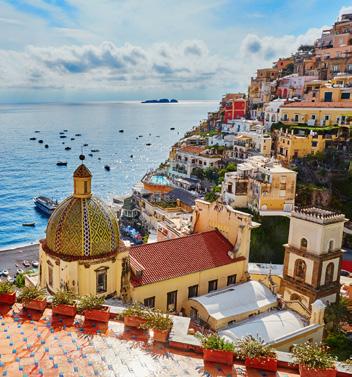
Tony Wilmott | Senior Archaeologist with Historic England, Tony has directed many excavations, and published several books and many articles in archaeological journals. He specializes in the Roman periods, with a particular interest in the Roman military. Join Tony on our 11th May departure.

Dr Simon Elliott | An award-winning and best-selling author, historian and broadcaster, Simon is an Honorary Research Fellow at the University of Kent. He is also a Trustee for the Council of British Archaeology. Join Simon on our 21st September departure.

One of the most beautiful cities in the world, Naples, known as Napoli in Italian, is deeply intertwined with that of the ancient Romans. Founded by the Greeks in the 8th century BC, Naples became a significant cultural and commercial hub. When the Romans took control of the city in the 4th century BC, they further developed it into a prominent part of their empire.
Under Roman rule, Naples flourished as a centre of the arts. The Romans built grand structures, including theatres, aqueducts and public baths, many of which still stand today. The city's strategic location along the coast made it an important port for trade and military purposes. Additionally, Naples was known for its luxurious villas and estates, which were popular among wealthy Romans seeking a retreat from the hustle and bustle of Rome.
Naples is brimming with ancient archaeological artefacts from the height of the Roman Empire. The Museum of Archaeology in Naples is one of the most important archaeological museums in the world. It houses a vast collection of artefacts from ancient Greece, Rome and Egypt. The museum is particularly renowned for its extensive collection of Roman artefacts from the nearby sites of Pompeii, Herculaneum and Stabiae, which were buried by the eruption of Mount Vesuvius in 79 AD.
YOUR TOUR ITINERARY
Day 1 - London - Naples - Cava de Tirreni
Day 2 - Positano & Amalfi
Day 3 - Pompeii
Day 4 - Naples
Day 5 - Baia & Pozzuoli
Day 6 - Herculaneum, Boscoreale & Terzigno
Day 7 - Capri
Day 8 - Cava de Tirreni - Naples - London
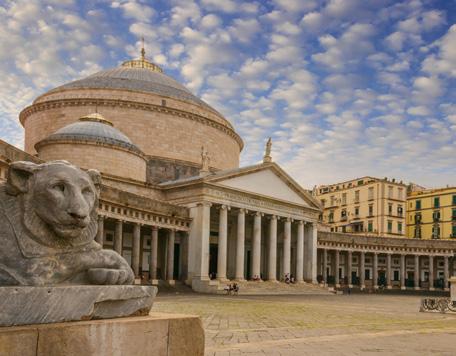
With crystal-clear azure waters, historic piazzas, unique sites, dramatic cliffs and an air of glamour, Capri is an absolute must-see while in this part of the world. Just 4 square miles in size, this limestone outcrop has captivated visitors for centuries. Emperors and Roman senatorial elites built seaside villas here to enjoy otium, or leisure, a fashion echoed by a few of the rich and famous today. Above the town sits Anacapri, a quieter village offering panoramic views from Monte Solaro, the island's highest point. Be sure to explore the area and visit Villa San Michele, built by Swedish physician Axel Munthe, which provides both beautiful gardens and stunning vistas. During our tour here, there’s plenty of time on this lovely island before returning to Naples by ferry.

When Vesuvius erupted in 79 AD, Herculaneum was buried under a thick layer of volcanic ash and mud, which preserved much of the town's architecture and artefacts remarkably well. The nature of the eruption has meant that organic materials have survived, making this a more poignant site than Pompeii: here we see a wonderfully preserved wine shop, the stunning House of the Stags with its pergola overlooking the sea and many fragments which attest to the everyday life in this upmarket city. Excavations have revealed well-preserved wooden structures, furniture, and even food, providing a unique glimpse into Roman life. Today, Herculaneum is a UNESCO World Heritage Site and a popular destination for tourists interested in history and archaeology.
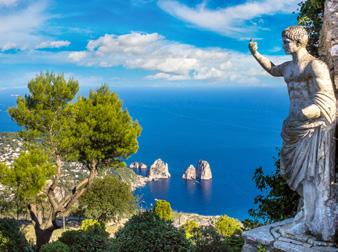
YOUR COMPREHENSIVE EXPERT GUIDED TOUR INCLUDES
Expert Guide Lecturer & Professional Tour Manager, entries to all sites as per the itinerary, field notes, all taxes & gratuities to local staff (drivers, waiters, site custodians)
Return flights from London Heathrow, private group transfers to/from the airport and hotel and all local transport aboard a private air-conditioned coach | 6 nights' in the Hotel Scapolatiello | 7 breakfasts, 5 lunches & 7 dinners | Water with all meals, wine & tea or coffee with dinner
Dates & prices per person based on Twin/Dbl share
11th - 18th May
£3,170
£2,970
Single Supplement £265 £0
21st - 28th Sep £3,170 £2,970
Single Supplement £265 £0
Save £200pp with our 2026 Special Offer
Rich archaeological sites and impressive artistic achievements
12 days from £5,300pp
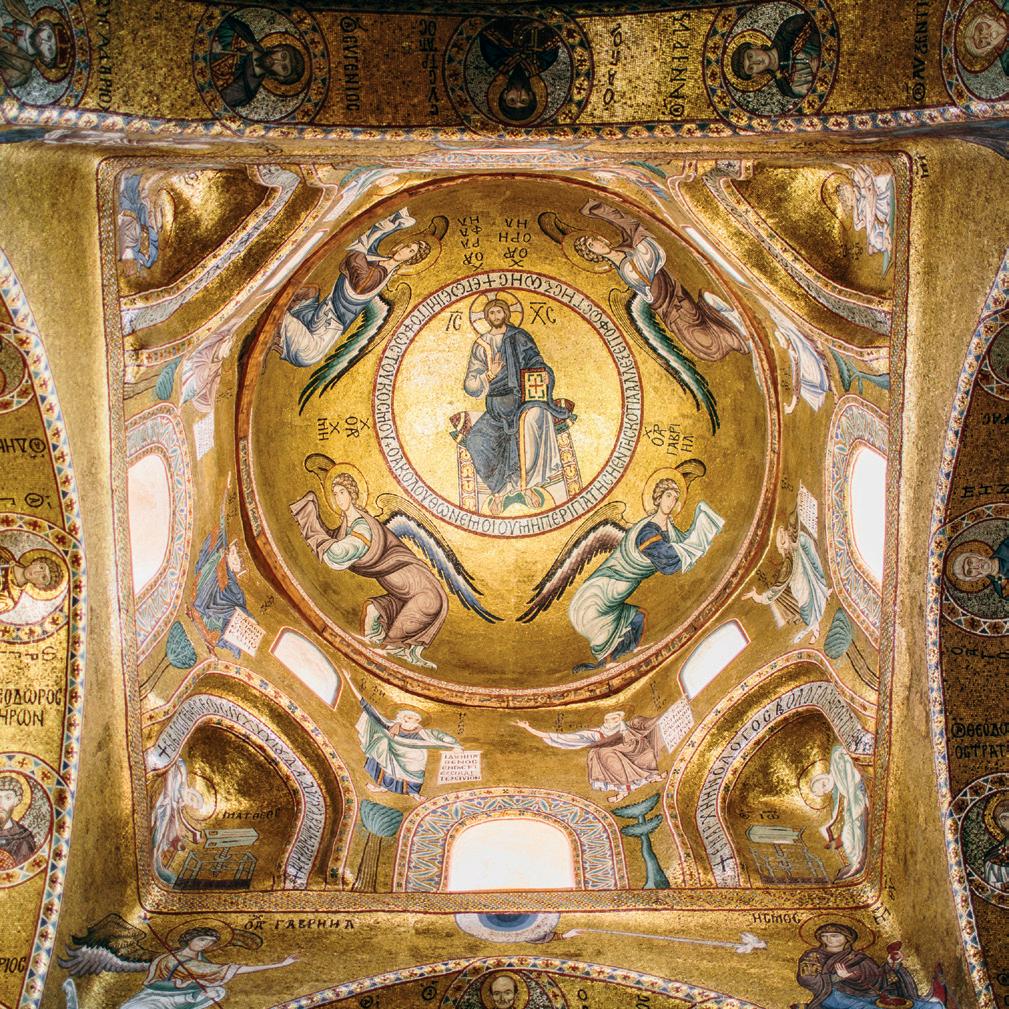
Some of the richest archaeological sites and the most impressive artistic achievements of European culture are to be found in Sicily, the largest island in a sea which was itself thought to lie at the centre of the ancient world, the Mediterranean. Controlling the trade routes between east and west and the pivot of power between the ‘superpowers’ of antiquity, Sicily was fought over and repeatedly won throughout the history of western civilisation. As part of Magna Graecia, the city of Syracuse was second only to Athens and Carthaginians wrestled with Rome for control here during the first Punic War. This tour presents an extraordinary panorama of changing identities – Phoenician, Greek, Roman, Byzantine, Arab and Norman.
Dr Doru Bogdan | A researcher and lecturer at the University of Alba Iulia in Romania, Doru is a specialist in Roman archaeology and has also supervised an array of fascinating excavations. Join Doru on our 24th March departure.

Oliver Gilkes | One of our longeststanding Guide Lecturers, Oliver has worked as a field and museum archaeologist in the UK, Albania and Italy. Oliver is still involved in projects in Albania and is considered one of just a handful of experts on Albanian archaeology in the UK. Join Oliver on our 22nd September departure.

Tony O'Connor | A specialist in the Roman Empire, Tony has excavated widely across Britain, Europe and North Africa. He first led a tour for Andante over 10 years ago and he just gets better and better! Join Tony on our 13th May departure.

Dr Jamie Sewell | An author of books and articles on the archaeology of towns in Hellenistic Italy, Jamie has 15 years’ worth of experience supervising excavations in Britain, Germany, Italy and Romania. Join Jamie on our 20th October departure.

YOUR TOUR ITINERARY
Day 1 - London - Catania
Day 2 - Segesta & Monreale
Day 3 - Palermo
Day 4 - Cefalù & Himara
Day 5 - Palermo – Motya - Marsala
Day 6 - Selinus
Day 7 - Agrigento
Day 8 - Piazza Armerina –Morgantina - Ortygia
Day 9 - Syracuse
Day 10 - Ortygia & Noto
Day 11 - Ortygia – Catania - Taormina
Day 12 - Catania - London
The Byzantine Empire was highly influential in Monreale, a city that later became the former hunting ground of the Norman kings of Sicily. By the late 12th century, when William II built Monreale, the Byzantine/ Eastern Roman Empire had passed its peak, yet glorious mosaics in its cathedral remained and signified what the Romans considered to be the highest level of superiority and culture in Europe. The opulent Norman-Byzantine cathedral and abbey was founded by King William II in 1174 and he dedicated it to the Virgin Mary. It was said that he had a vision of her, in which she told him where he could find treasure to pay for the cathedral. The 68,000 square feet of beautiful mosaics depict characters from the story of Genesis, with images of the Virgin Mary and further on, of Christ crowning the King.
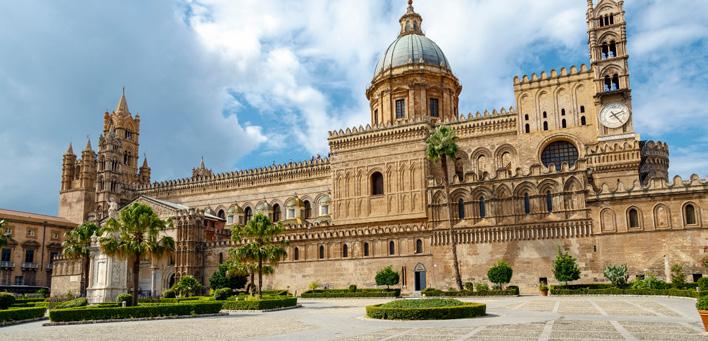
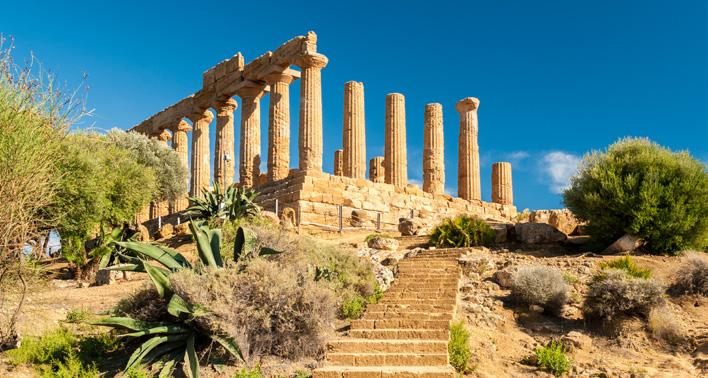
Known as the ‘Valley of the Temples, the archaeological area of Agrigento was taken over in 210 BC by the Romans during the Second Punic War and under new rule was renamed Agrigentum. Founded by the Greeks in the 6th century BC and after a long rule by the Carthaginians, the city entered a renaissance period during Roman occupation but later saw a decline as the Empire began to collapse.
YOUR COMPREHENSIVE EXPERT
GUIDED TOUR INCLUDES
Expert Guide Lecturer & Professional Tour Manager, entries to all sites as per the itinerary, field notes, all taxes & gratuities to local staff (drivers, waiters, site custodians)
Return flights from London Gatwick, private group transfers to/from the airport and hotel and all local transport aboard a private air-conditioned coach | 4 nights' in Palermo, 1 night in Marsala, 2 nights' in Argrigento, 3 nights' in Syracuse and 1 night in Taormina | 11 breakfasts, 8 lunches & 9 dinners | Water with all meals, wine & tea or coffee with dinner
Dates & prices
per person based on Twin/Dbl share
24th Mar - 4th Apr £5,655 £5,300
Single Supplement £875
13th - 24th May £5,995 £5,620
Single Supplement £890
22nd Sep - 3rd Oct £5,995 £5,620
Single Supplement £890
20th - 31st Oct £5,995 £5,620
Single Supplement £890
Save up to £375pp with our 2026 Special Offer
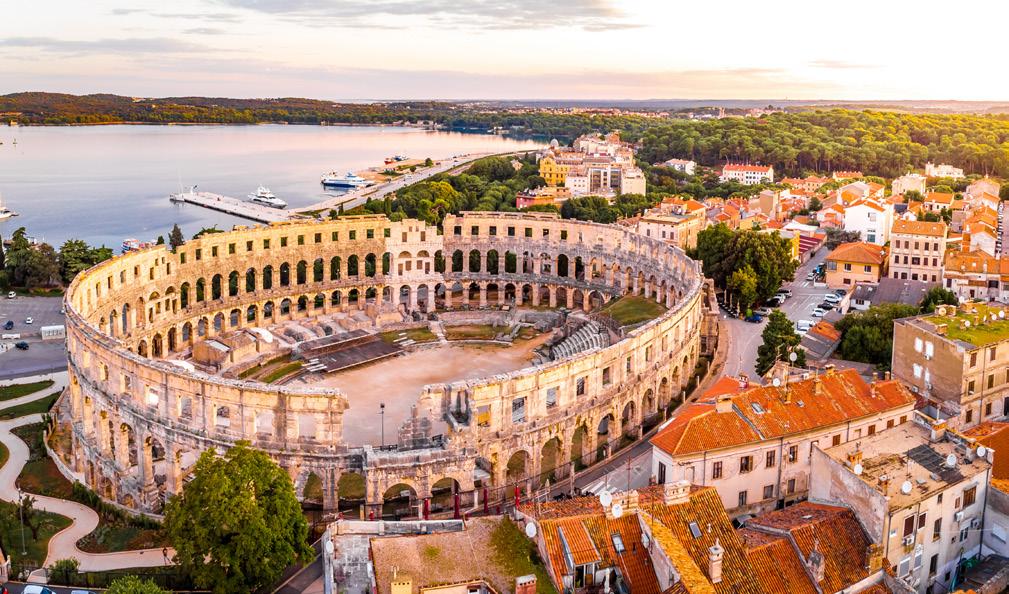
With its staggeringly beautiful coastline, the idyllic peninsula of Istria boasts a rich history linking it to the Veneti and is, today famed for its wonderful ancient ruins, as well as its beautiful, Venetian cities. Little is known about the ancient Histri who gave the peninsula its name, save for the fact that it took Rome some time to conquer it in the 2nd century BC because of its tenacious citizens. When incorporated into the Roman Empire, it was ruled alongside Venetia, an association which foreshadowed Venetian dominance, beginning in the 9th century when the maritime republic started its inexorable conquest of the Illyrian coast.
It was only during the Napoleonic era that Istria slipped from Venetian control when it came under the dominion of the Austro-Hungarian Empire. History has, inevitably, shaped Istria, starting with the splendid Roman ruins found in its cities, notably Pula, which has some of the finest ruins anywhere outside of Italy, including a superb Temple of Augustus and a famous amphitheatre. Trieste, the busy port city of the Austro-Hungarians, owes much of its elegance to the central European influence imbued in the period of Habsburg domination, although it also contains a fine Roman temple. In turn, although it is home to Roman remains, Poreč is notable for its extraordinary 6th-century Euphrasian Basilica, an early Byzantine church which is scintillating with its shimmering gold mosaics. Thus, any visit to this lovely region offers a wonderful immersion into a range of bygone periods, not simply just the Roman times.

The wonderful remains of Pula, a historic gem on the southern tip of the Istrian peninsula, offers precious testimony to the Roman presence and influence in this region. Most prominent among these is the stunning amphitheatre, featuring the underground service rooms, as well as the four outer towers, which contained water for the sparsiones sprinkled on the spectators during performances, plus evidence of the structures necessary for the awnings used to shade the spectators. Another treasure is the Roman Forum, home to the Temple of Augustus, one of the bestpreserved Roman temples outside of the Italian peninsula. Dating from the same period is the Arch of the Sergii, which was both a city gate as well as a commemoration of the victory at Actium, while nearby is the Gate of Hercules, recognisable from the high relief sculpture of the hero’s bearded head, together with his club. The wellpreserved Roman theatre is astounding too, built into the hillside on which the castle now sits and, along with the other ruins here, instantly transports visitors to an ancient Italianate world.
Dr Eireann Marshall | An Honorary Research Fellow for the Open University, Eireann has led many Andante tours. She won the Top History and Culture Guide prize at Wanderlust magazine’s 2019 World Guide Awards and has also published a variety of articles on Roman North Africa.

Delve deeper into imperial Rome at Vizula Archaeological Park, a stunning peninsula hiding a wealth of remains, with evidence showing habitation here from the Neolithic period onwards. Just one of the striking and significant sites is the Imperial Villa, whose grandeur underlines the prosperity of some of Vizula’s inhabitants. With its impressive size, rich decorations, stunning mosaics and gleaming marble, it is no wonder that this is one of the most luxurious and attractive villas found on the Adriatic coast that stems from the Roman Empire. One of the elite resorts of its day, the villa boasts spectacular views over the Gulf of Medulin and took three decades to excavate, leading to valuable insight into those who were once drawn here.
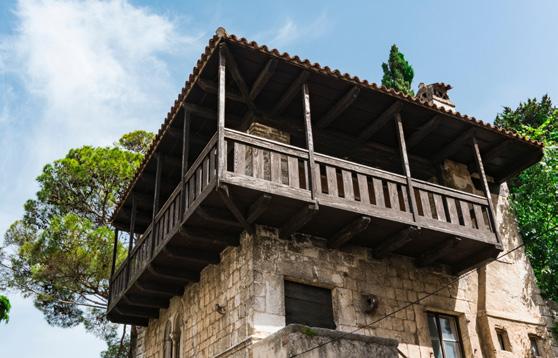
YOUR TOUR ITINERARY
Day 1 - London - Pula
Day 2 - Pula & Vizula
Day 3 - Monkodonja - Poreč - Trieste
Day 4 - Trieste
Day 5 - Trieste - Pula - London

Located in North Eastern Italy on the border with Slovenia, the beautiful city of Trieste is richly intertwined with Roman culture and influence, strongly contributing to its economic development centuries ago. Originally founded as a Roman colony in the 1st century BC, Trieste (then known as Tergeste), served as a significant hub for trade and military operations, thanks to its strategic position on the Adriatic Sea. The city’s elegant avenues are dotted with a whole host of archaeological treasures to explore, such as the Cattedrale di San Giusto, built between the 9th and 10th centuries on top of an early Christian church and a Roman temple, notable for its Venetian apsidal mosaics. Just outside the cathedral lies the remains of the Roman Forum. Once the bustling heart of the city, it’s fascinating to simply walk in the footsteps of politicians, traders, merchants and citizens, gaining an insight into daily Roman life along the way. There is plenty more to see too, including the Arco di Riccardo, one of the ancient city gates which monumentalised the entrance to the Cardo, and the well-preserved Roman theatre, dating back to the 1st century BC. Still occasionally used for al fresco shows in the summer, it is yet another symbol of the Roman’s enduring legacy and continued presence within the modern world.

The lovely town of Poreč is situated on the western side of the pretty Istrian peninsula. Inhabited since prehistoric times, it was a Roman castrum in the second century BC, making use of the natural harbour, and became a municipium during the time of Augustus. The Roman Forum can be found at Marafor Square, where remains of some of the Roman temples are still visible, as well as paving from the forum itself. Nearby is the pediment of the Temple of Neptune, once the largest in Istria and dedicated to the Roman god of the sea. Perhaps the most notable site in Poreč is the Euphrasian Basilica, housed in a complex that includes a baptistery and bell tower and a landmark that cemented Poreč as an ecclesiastical centre. This UNESCO-listed building is a particularly fine example of Byzantine architecture, built in the 6th century on top of an older, 4th-century basilica, as well as a Roman domus, a townhouse occupied by the wealthy. Inside, the eye is caught by the staggering mosaics in this complex, while the oratory retains a mosaic floor that belonged to the domus.
YOUR COMPREHENSIVE EXPERT GUIDED TOUR INCLUDES
Expert Guide Lecturer & Professional Tour Manager, entries to all sites as per the itinerary, field notes, all taxes & gratuities to local staff (drivers, waiters, site custodians)
Return flights from London Gatwick, private group transfers to/from the airport and hotel and all local transport aboard a private air-conditioned coach | 2 nights' in the Park Plaza Histria Pula and 2 nights’ in the Hotel Continentale, Trieste | 4 breakfasts, 4 lunches & 3 dinners | Water with all meals, wine & tea or coffee with dinner
Dates & prices
per person based on Twin/Dbl share
23rd - 27th May £2,825 £2,650
Single Supplement £450
Save £175pp with our 2026 Special Offer
Amongst diverse landscapes discover some of Europe’s finest Roman remains 7 days from £2,985pp

Provincial Romana was founded in France at the end of the 2nd century BCE, as the Romans grew their Empire across Europe and an extensive building programme of grand amphitheatres, baths and aqueducts emerged with it, built in the days of the high empire to impress and subdue the native Gallic tribes. The idyllic landscapes of Provence are therefore home to some of Europe’s finest Roman remains. We discover ancient ruins and magnificent temples, so unspoiled it’s been suggested that the Romans never left this province. Explore two of the best-preserved monuments in Europe – the Maison Carreé in Nîmes and the theatre of Orange, a UNESCO World Heritage Site, as well as less well-known sites like the Gallo-Roman town of Glanum set in the rocks of Les Alpilles.
Known as the French Rome, it’s no wonder that the flourishing city of Nîmes is home to a vast array of Roman treasures. Just a few highlights include Porte d’Auguste, an ancient Roman gate constructed during the reign of Emperor Augustus, along with Maison Carrée, one of the best-preserved Roman temples in the world and dedicated to Gaius and Lucius Caesar, plus the Roman amphitheatre of Arènes de Nîmes, built around 70 AD and used for gladiatorial contests and other public events. Elsewhere, the Musée de la Romanité provides an immersive experience amongst over 5,000 artefacts, including mosaics, statues and everyday objects from the Roman era, while the Diane Temple is incredible, featuring a vaulted ceiling, large arches and intricate stone carvings, and the Tour Magne offers a wonderful way to conclude a day of exploration, the only remaining tower of many which once formed part of the Augustan fortifications protecting the city.
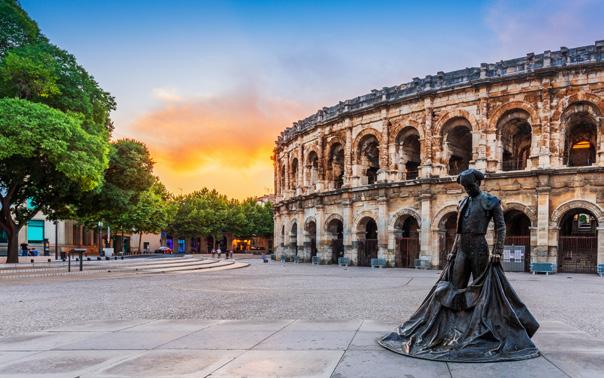
Guide Lecturer for this tour
Professor Tony King | Lecturer in Archaeology at the University of Winchester, Tony has excavated both in Britain and abroad. He is also a specialist in Roman archaeology and an expert in animal bone analysis.

Driving through Provence, it feels as though historic gems are around every corner, such as the Glanum Archaeological Site, once an ancient city founded by the Celts and later developed by the Greeks and Romans, and the UNESCO-listed Pont du Gard, an ancient Roman aqueduct bridge. Built in the 1st century AD, it is a remarkable feat of engineering and a testament to the ingenuity of Roman architecture, which remains one of the best-preserved examples of an aqueduct from this time. To learn more, the Pont du Gard Museum provides a comprehensive insight into its history and construction, featuring a variety of exhibits that detail the engineering marvels of Roman aqueducts, the daily life of the Romans who built them and the historical significance of the bridge.
YOUR TOUR ITINERARY
Day 1 - UK - Paris - St. Remy
Day 2 - Nimes
Day 3 - Glanum & Pont du Gard
Day 4 - Orange
Day 5 - Arles
Day 6 - Aix en Provence
Day 7 - St. Remy – Avignon - UK
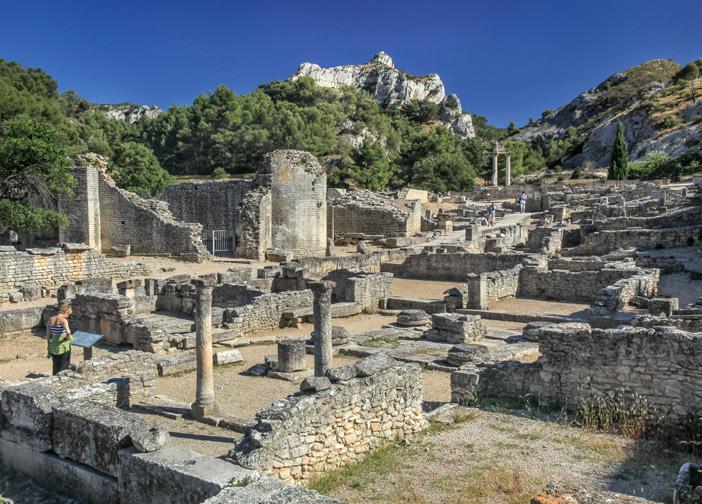
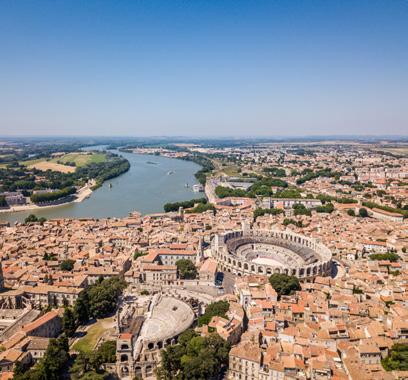
The city of Arles boasts numerous Roman and Romanesque monuments, many of which are UNESCO World Heritage Sites, including the spectacular Arles Amphitheatre, a testament to its ancient past and still used today for various events. The Archaeological Museum is a recognised institution dedicated to the preservation and exhibition of ancient artefacts from the region with an extensive collection of mosaics, sculptures, sarcophagi and everyday objects that provide insight into the lives of the ancient inhabitants here. A real highlight is the Arles Rhône 3, a remarkably well-preserved Roman barge, discovered in the Rhône River. Nearby, the Barbegal Aqueduct is an outstanding structure considered one of the most impressive examples of Roman engineering and ingenuity. Used to supply water to the city of Arles, it is unique in its incorporation of a complex watermill system, which is believed to have been used for milling grain.
YOUR COMPREHENSIVE EXPERT GUIDED TOUR INCLUDES
Expert Guide Lecturer & Professional Tour Manager, entries to all sites as per the itinerary, field notes, all taxes & gratuities to local staff (drivers, waiters, site custodians)
Head to the historic town of Orange to visit the Arch of Orange, a UNESCO World Heritage site which was built during the reign of Augustus to celebrate the victories of the Roman army. Other relics of the past are just waiting to be discovered here, including the Roman Theatre of Orange, originally able to accommodate up to 10,000 spectators and recognised for its exceptional acoustics, and the fascinating items in the History Museum of Orange. Nearby, charming Vaison-la-Romaine is another must-see, renowned for its ancient Roman ruins such as a well-preserved theatre, luxurious villas and intricate mosaics, along with Puymin, an archaeological site located within the ancient city and boasting a Roman Bridge. Known as the Pont Flavien, the bridge is an example of vigorous ancient Roman engineering and is unique due to being one of the few surviving Roman bridges with its original decorative arches intact.
Return train travel from London St. Pancras, private group transfers to/from the train station and hotel and all local transport aboard a private air-conditioned coach | 6 nights' at a hotel in St. Remy | 6 breakfasts, 5 lunches & 6 dinners | Water with all meals, wine & tea or coffee with dinner
Dates & prices per person based on Twin/Dbl share 19th - 25th Oct £3,255 £2,985
Single Supplement £395
Save £270pp with our 2026 Special Offer
10 days from £5,300pp

Germany's history with the Roman Empire is both rich and complex. The Roman Empire first made contact with the Germanic tribes during the 1st century BC. The most notable event in this early period was the Battle of the Teutoburg Forest in 9 AD, where an alliance of Germanic tribes ambushed and destroyed three Roman legions. This episode – long remembered in Rome and etched in Augustus’ memory – brought about a change in Roman strategies in Germany.
Over the following centuries, the Romans maintained a presence along the Rhine and Danube rivers, constructing fortifications and engaging in trade and occasional conflict with the Germanic tribes. The Roman influence can still be seen today in the remnants of their settlements, roads and fortifications found throughout modern Germany.
In this beautiful part of Europe often overlooked by tourists, we explore extraordinary museums, such as the RomanoGermanic Museum in Cologne and the Museum fur Antike Sciffahrt in Mainz, stunning houses such as the Ahrweiler Villa and the Villa Nennig, along with the limes strategies for controlling its borders. We end with Aachen, the stunning capital of the Holy Roman Empire with its unique cathedral.
One of the oldest cities in Germany, Cologne was founded by the Romans around 39 BC as a military outpost and later became the capital of the Roman province of Germania Inferior in 50 AD. Evidence of Cologne’s Roman past can still be seen in various archaeological sites, such as the Roman-Germanic Museum, which houses a vast collection of artefacts, including mosaics, pottery and statues. The remains of the ancient city wall and the Praetorium, the former Roman governor's palace, are also notable historical landmarks that highlight Cologne's significance during the Roman era.
Romano-Germanic Museum has an excellent collection of artefacts from the Roman colony and is built over a section of a Roman road, as well as an impressive elite domus which contains a wonderfully preserved mosaic of Dionysus.

Tony Wilmott | Senior Archaeologist with Historic England, Tony has directed many excavations, and published several books and many articles in archaeological journals. He specializes in the Roman periods, with a particular interest in the Roman military.

Day 1 - London - Düsseldorf - Cologne
Day 2 - Xanten
Day 3 - Cologne
Day 4 - Cologne - Boppard - Braubach
Day 5 - Zugmantel, Saarburg & Feldberg
Day 6 - Braubach - Mainz - Trier
Day 7 - Trier
Day 8 - Porta Nigra & Villa Borg
Day 9 - Trier - Aachen
Day 10 - Aachen - Dusseldorf - London
Zugmantel and Saalburg are ancient Roman forts located in the Taunus Mountain range of Germany. It was part of the Upper Germanic-Rhaetian Limes, which was a frontier line of the Roman Empire. The fort served as a strategic military outpost to protect the Roman provinces from Germanic tribes. Today, visitors can explore the remnants of the fort, including sections of the defensive walls and the reconstructed watchtower.
The limes are a 500km boundary fortified with great banks and ditches overlooked by 900 watchtowers and patrolled from 60 forts. The site offers a glimpse into the Roman military architecture and the historical significance of the Roman Empire's northern frontier.
The Saalburg fort was part of the Roman frontier known as the Limes Germanicus, which marked the boundary of the Roman Empire in the province of Germania. The site includes well-preserved remains of the fortifications, gates, barracks, and other buildings, providing a fascinating glimpse into Roman military life. Today, the UNESCO-listed site at Saalburg serves as an open-air museum where visitors can explore reconstructed buildings, view artefacts, and learn about the history of the Roman Empire's presence in Germany.

The Romans were attracted to Aachen due to its natural hot springs, which they used for their baths and therapeutic purposes. They established a settlement known as "Aquae Granni," named after the Celtic god of healing, Grannus. This settlement grew in importance as a spa destination and became a key point in the network of Roman roads that crisscrossed the region. The remnants of Roman baths and artefacts found in Aachen today are a testament to its ancient Roman heritage.
A city redolent of Germanic identity, it is where the Holy Roman Emperors were crowned from the 9th to the 16th centuries. In a tour which started with the imperial period, and continued to the late antique period, it is fitting that it ends with the Holy Roman Empire.
Be sure to visit the Treasury, richly endowed by Holy Roman emperors, including Charlemagne himself. It includes the Aachen Gospels and a diptych of Christ from the Carolingian period, as well as the Lothar cross from the time of Otto III. The incredible UNESCO-listed Cathedral of Aachen was built at the order of Charlemagne to resemble the Basilica of San Vitale in Ravenna and to challenge the Basilica of San Giovanni in Lateran in splendour. Richly decorated with marble taken from Rome and Ravenna, this cathedral is one of the oldest in Europe.

Some of the most spectacular and significant Roman remains in Germany can be found at Trier, a UNESCO-listed site. Trier, often referred to as the ‘Second Rome,’ is located on the Moselle River.
The city was of great strategic importance and boasts some fantastic museums displaying key Roman artefacts, such as the Rheinsches Landesmuseum, which contains the Trassem gold hoard from 1600 BC.
Another must-see is Constantine’s Basilica, built by the emperor Constantine as part of a palace complex and which remains the largest extant ancient hall.
The famous Porta Nigra is a large Roman city gate in Trier. The historic landmark is a UNESCO World Heritage Site and is in remarkable condition due to its transformation into two superimposed churches as well as the Kaiserthermen Baths, whose impressive remains were built in the 4th century.
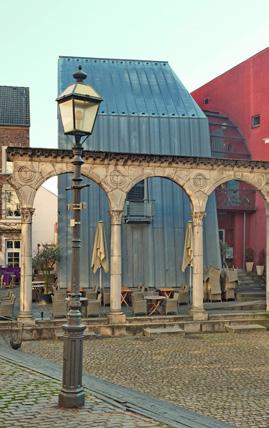
YOUR COMPREHENSIVE EXPERT GUIDED TOUR INCLUDES Expert Guide Lecturer & Professional Tour Manager, entries to all sites as per the itinerary, field notes, all taxes & gratuities to local staff (drivers, waiters, site custodians)
Return flights from London Heathrow, private group transfers to/from the airport and hotel and all local transport aboard a private air-conditioned coach | 3 nights' in the Eden Hotel Früh Am Dom, Cologne, 2 nights' in the Zum Weißen Schwanen, Braubach, 3 night's in the Hotel Park Plaza, Trier and 1 night in the Parkhotel Quellenhof, Aachen | 9 breakfasts, 9 lunches & 9 dinners | Water with all meals, wine & tea or coffee with dinner
Dates & prices
per person based on Twin/Dbl share
27th Sep - 6th Oct £5,655 £5,300
Single Supplement £660
Save £355pp with our 2026 Special Offer
11 days from £4,755pp
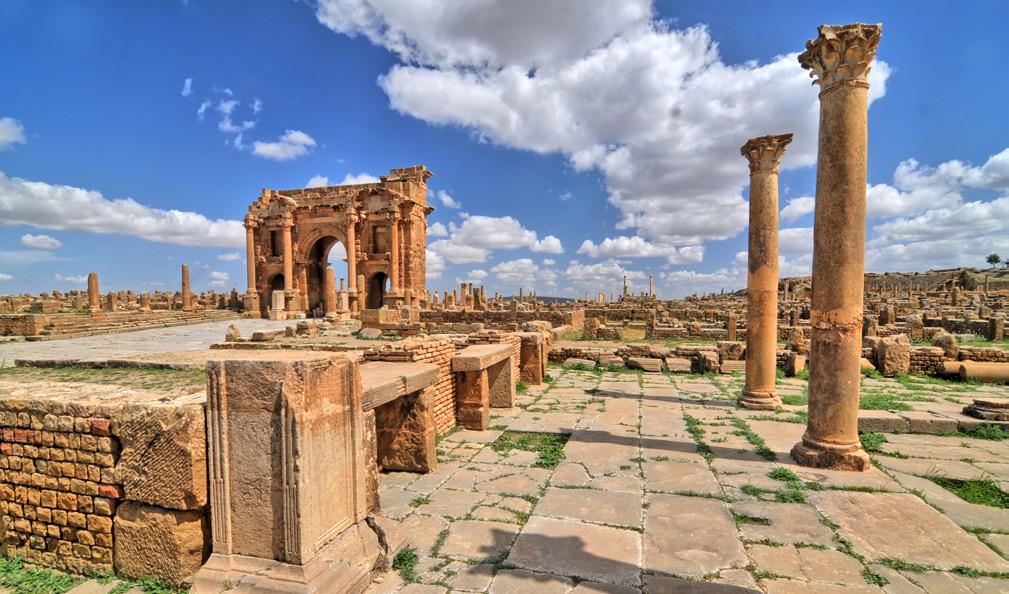
Algeria is a country with a rich history that dates back to ancient times. One of the most significant periods in its history is the Roman civilization.
The Romans first arrived in Algeria in the 2nd century BC and established numerous settlements, including the prominent city of Timgad, which is now a UNESCO World Heritage site. The Roman influence in Algeria is evident in the well-preserved ruins of temples, amphitheatres, and aqueducts found throughout the country. These structures highlight the architectural and engineering prowess of the Romans and their ability to integrate their culture with the local Berber traditions. The Roman period in Algeria lasted until the 5th century AD, when the region was invaded by the Vandals and later the Byzantines.
The many Roman sites that can be found scattered across the landscape pay testament to a wealthy province with cities equipped with running water, palatial bath houses, hypocaust heating, opulent latrines and monumental architecture and triumphal arches. The museums, which have been little publicised, contain some astounding artefacts and illuminate this fascinating history even further.
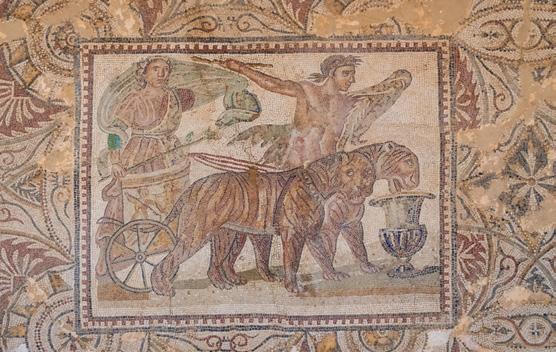
Cherchell is a coastal town known for its rich historical significance and beautiful Mediterranean scenery. Originally founded by the Phoenicians, it was later developed by the Romans who named it Caesarea Mauretaniae. Cherchell boasts several archaeological sites, including Roman ruins, ancient baths and a theatre, making it a fascinating destination for history enthusiasts.
The Roman city of Tipasa, a UNESCO World Heritage Site overlooking the sea, has impressive remains both of the high Roman Empire and of the early Christian period. The city is renowned for its archaeological sites, which include well-preserved ruins of Roman temples, amphitheatres and basilicas. The town's strategic location along the Mediterranean Sea made it an important trading hub in ancient times.
Dr Farès K Moussa | Specialising in religious art and artistic practice, Farès has both written and researched on Romans and Phoenicians in Tunisia, Libya, Morocco and Sardinia, as well as on the subject of prehistoric rock art. Join Farès on our 20th March departure..

Tony O'Connor | A specialist in the Roman Empire, Tony has excavated widely across Britain, Europe and North Africa. He first led a tour for Andante over 10 years ago and he just gets better and better! Join Tony on our 1st November departure.

Annaba, a port city in northeastern Algeria, is renowned for its rich history and cultural heritage. Located on the Mediterranean coast, it serves as a significant hub for trade and tourism. The city boasts beautiful beaches, vibrant markets and a blend of French and Algerian architecture. Notable landmarks include the Basilica of St. Augustine, a stunning example of religious architecture, and the ruins of the ancient city of Hippo Regius, which offer a glimpse into the region's Roman past. Annaba's mild climate and scenic landscapes make it a popular destination for both locals and tourists seeking to explore Algeria's diverse offerings.
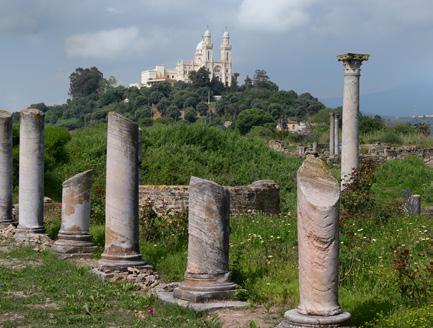
Batna is situated in the Aurès Mountains, which provides it with a picturesque landscape and a moderate climate. Batna is also a gateway to several important archaeological sites, including the Roman ruins of Timgad and is a UNESCO World Heritage site. The city has a vibrant community and is a hub for education and commerce in the region.
Timgad is an ancient Roman city founded by Emperor Trajan around 100 AD, principally as a colony for veterans of the Legio III Augusta. Known for its well-preserved ruins, Timgad offers a fascinating glimpse into Roman urban planning and architecture. The city was designed on a grid plan, featuring a rectangular layout with a central forum, a triumphal arch, and various public buildings such as baths, a library and a basilica. The site also includes a large theatre that could accommodate up to 3,500 spectators. Timgad is a UNESCO World Heritage site, celebrated for its remarkable state of preservation and historical significance, providing insight into the life and culture of a Roman colonial town in North Africa.
YOUR TOUR ITINERARY
Day 1 - London - Algiers
Day 2 - Algiers
Day 3 - Cherchell & Tipasa
Day 4 - Algiers - Annaba
Day 5 - Annaba - Constantine
Day 6 - Tiddis & Constantine
Day 7 - Constantine - Djémila - Setif
Day 8 - Setif - Batna
Day 9 - Batna - Timgad - Biskra
Day 10 - Biskara - Algiers
Day 11 - Algiers - London
Nestled in the mountains, Tiddis offers a glimpse into Roman urban planning and architecture. Visitors can explore various structures, including a forum, a basilica and a triumphal arch. Spectacularly located, the sandstone constructions at Tiddis have a distinctive ochre-red colour from the deep red of the earth in the surrounding area which is washed down from the hilltop and carried by the wind. The site has been occupied at least since the Neolithic period and several circular ‘bazina’ burial monuments from the pre-Roman Numidian period are visible here. Known as the ‘City of Bridges’ due to its numerous picturesque bridges spanning the Rhumel River, Constantine is a place where history and modernity blend seamlessly. The city is renowned for its dramatic landscape, perched on a rocky outcrop with deep ravines and lush valleys below. Constantine's history dates back to ancient times when it was known as Cirta, a major city of the Numidian Kingdom. It later became a prominent centre of the Roman Empire in North Africa. The city's rich historical heritage is evident in its many archaeological sites, museums, and wellpreserved structures, such as the ancient Roman aqueducts and the Kasbah, a fortress dating back to the Ottoman era.
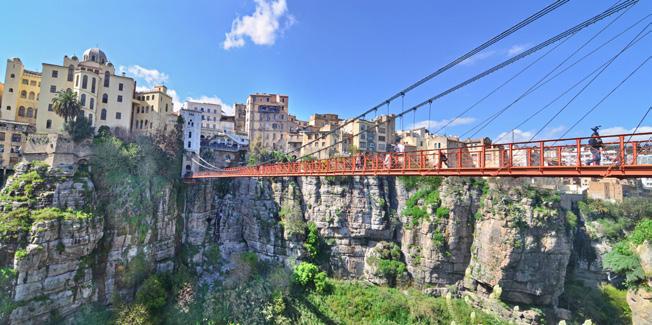

YOUR COMPREHENSIVE EXPERT GUIDED TOUR INCLUDES
Expert Guide Lecturer & Professional Tour Manager, entries to all sites as per the itinerary, field notes, all taxes & gratuities to local staff (drivers, waiters, site custodians)
Return flights from London Gatwick, private group transfers to/from the airport and hotel and all local transport aboard a private air-conditioned coach | 4 nights' in the Lamaraz Hotels, Algiers, 1 night in the Sheraton Annaba Hotel, Annaba, 2 nights' at a hotel in Constantine, 1 night in the Park Mall Hotel & Conference Center, Setif, 1 night in the Trajan Hotel, Batna, and 1 night in the Vescera Hotel, Biskra | 10 breakfasts, 9 lunches & 10 dinners | Water with all meals, tea or coffee with dinner
Dates & prices per person based on Twin/Dbl share
20th - 30th Mar £5,070 £4,755
Single Supplement £635
1st - 11th Nov £5,070 £4,755
Single Supplement £635
Save £315pp with our 2026 Special Offer
Discovering Jordan's dramatic landscapes and Roman treasures
10 days from £4,295pp
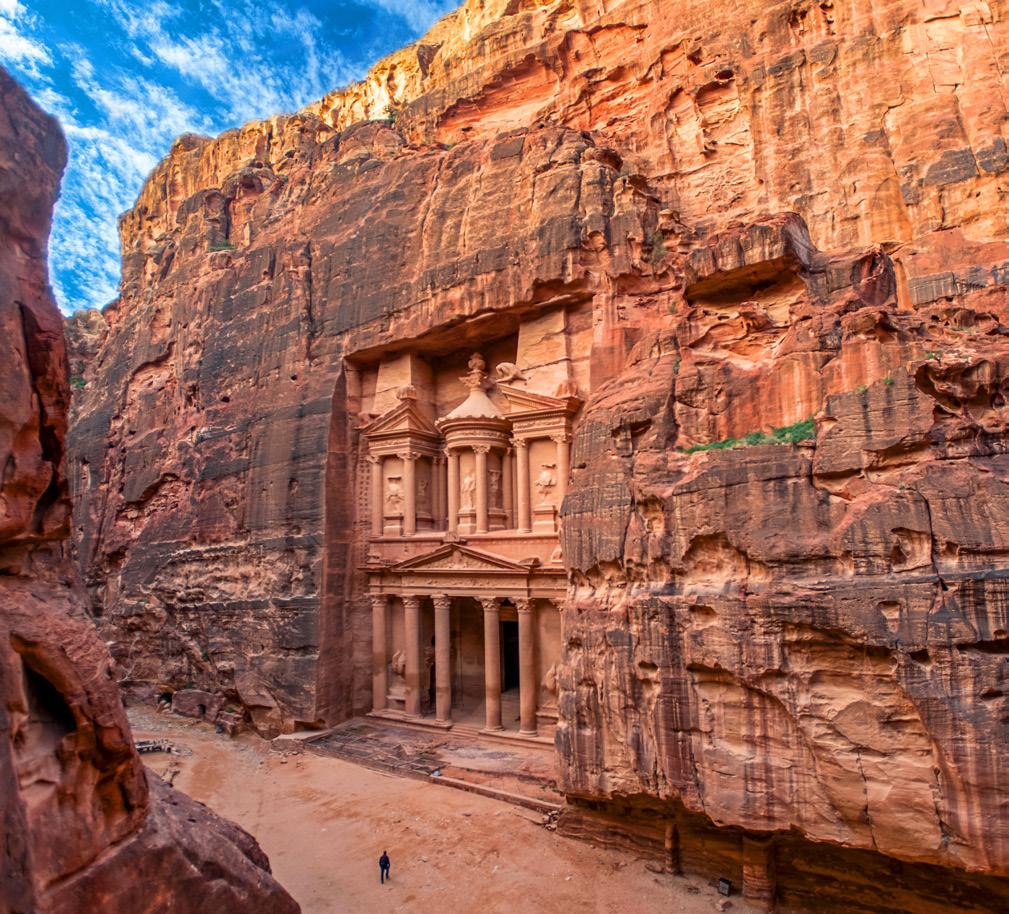
After the conquest of the region by General Pompey, Jordan soon became an integral part of the Roman Empire, leaving behind a rich tapestry of historical and architectural marvels that can still be seen today.
Indeed, throughout the recorded past, Jordan shook to the often-heavy footfalls of conquerors and felt the sweeping movements of peoples and customs, of prophets and kings. Its Iron Age history, home to the Israelites, Ammonites, Edomites and Moabites, is documented in the Old Testament, while the upheavals caused by the mighty Assyrian and Babylonian Empires and the Roman Empires are recorded in the New Testament. Here the East first met the revolution of Hellenism, bringing its world philosophy and technological expertise.
The gorges of the wadi beds, the deserts of black basalt and golden sand plus the end of the Great Rift Valley containing the salty waters of the Dead Sea create dramatic backdrops for its historic tales, with Petra’s tombs and temples just being a fraction of Jordan’s story. As well as these iconic gems, we explore traces of Roman legions, biblical tribes, Christian crusaders and Islamic caliphates in this promised land of archaeology and fascinating history, discovering along the way how the Roman road network in Jordan facilitated trade and movement across the empire too, contributing to the economic prosperity of the region.
Nick Jackson | A graduate of the Institute of Archaeology at UCL, Nick is an archaeologist and historian with over 20 years of excavation experience.

“
One of the best tours I have been on. Nick was an excellent enthusiastic lecturer. Choice of sites spot on.
Tour manager and local guide enabled our trip to run smoothly.”
Known as the ‘Pompeii of the East’, Jerash (ancient Gerasa) is set in the pine valleys of the biblical land of Gilead and is one of the best-preserved Roman cities in this part of the world. Hidden in the sand for centuries before its excavation, it was founded as a Greek city by Alexander the Great but only truly flourished under the Romans, becoming a fascinating example of Roman urbanism that rivals ancient cities found in Italy. The architecture is particularly fine and includes the impressive Hadrian’s Arch (built in AD 129 to mark Emperor Hadrian’s visit), the Hippodrome, where thrilling chariot races took place in front of thousands of spectators, as well as the Corinthian columns of the Temple of Artemis and the Oval Plaza – framed by a magnificent colonnade – a unique feature of the Forum. Strolling between these wonders along centuries-old avenues is undoubtedly a highlight of any trip to Jordan.
YOUR TOUR ITINERARY
Day 1 - London - Amman
Day 2 - Wadi Seer - Dead Sea - Amman
Day 3 - Gadara - Jerash
Day 4 - Amman
Day 5 - Umm al-Jimal
Day 6 - Umm al-Rasas - Kerak
Days 7 & 8 - Petra
Day 9 - Little Petra - Wadi Rum
Day 10 - Amman - London
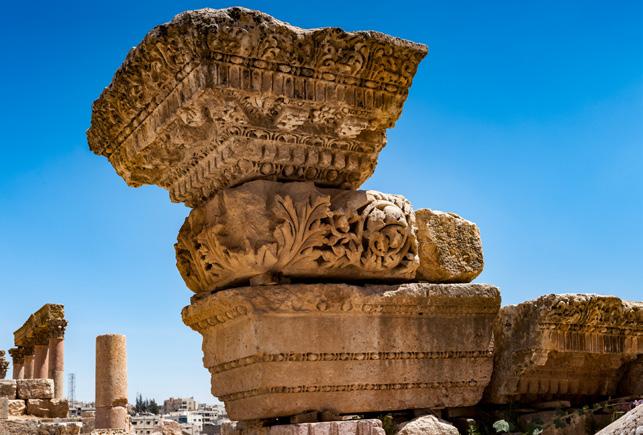
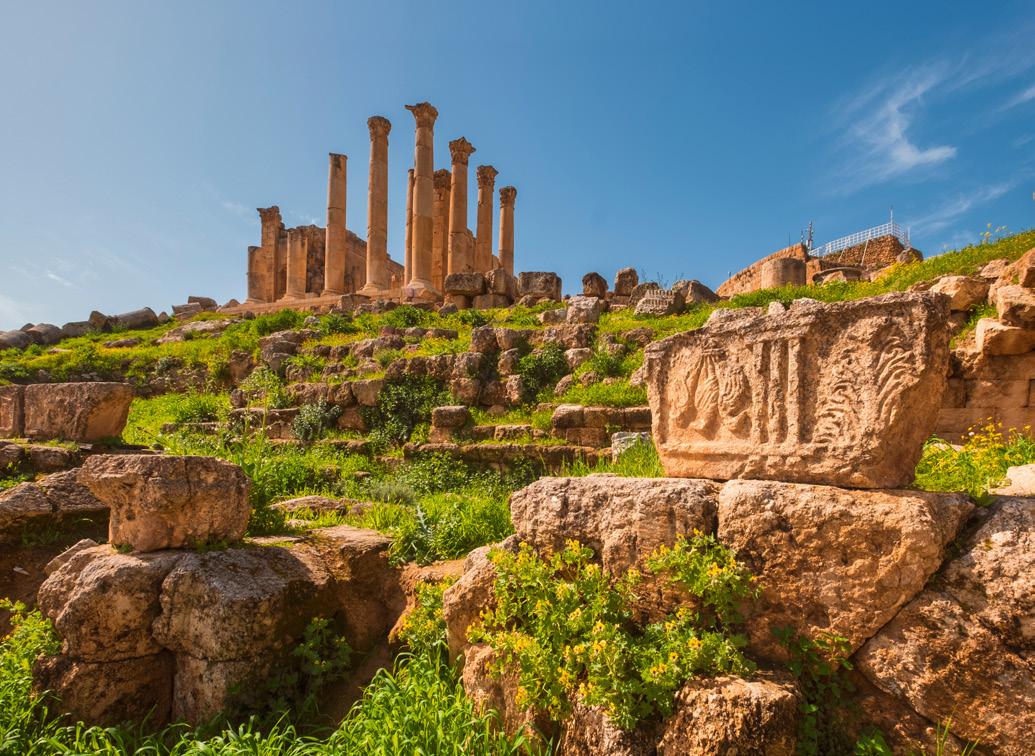
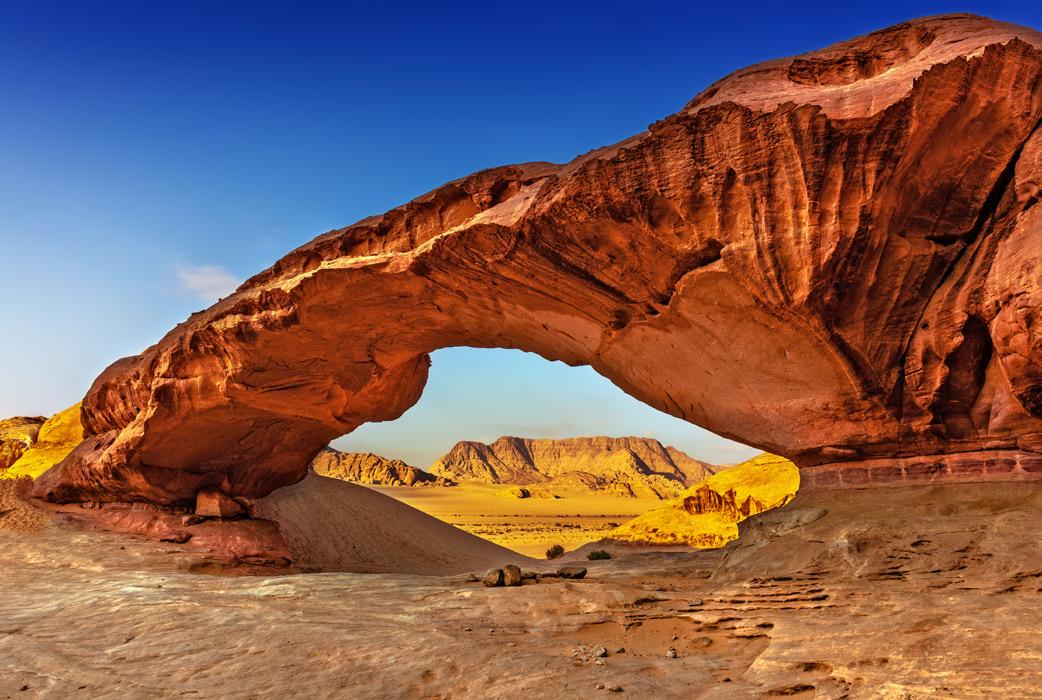
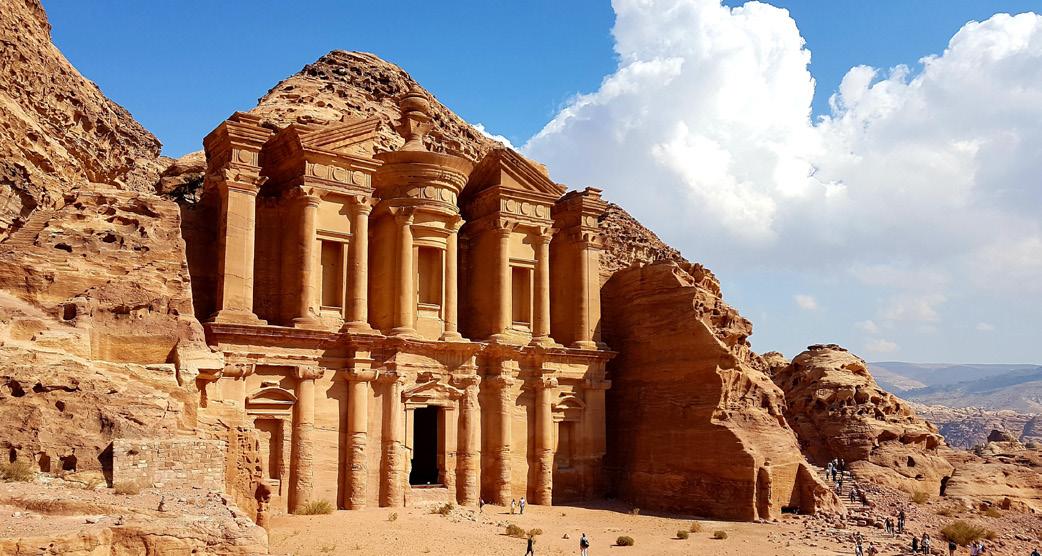
There are plenty more iconic spots in Jordan where if you scratch the surface, you will no doubt find influences and stories dating back to the Roman period. While taking 4x4s through the otherworldly scenery of Wadi Rum, made famous by the filming of ‘Lawrence of Arabia’, consider that this was once home to the largest Roman copper mine in the empire. Similarly, when strolling through spectacular Petra, look out for the many Roman marks on the ancient city, from the style of its landmarks and sculptures to the layout itself. The incredibly straight Colonnaded Street once ran through the centre of the bustling metropolis and, with its large columns, was unlike anything previously seen in Petra. Like many other places across the globe, the Romans certainly left their mark and created a century-spanning legacy here.


Jordan’s modern capital of Amman juxtaposes wonderfully with its ancient ruins. The Archaeological Museum is a gem to explore and was purposefully established on Citadel Hill so that the crumbling Roman, Byzantine and Arab Citadel would forever be a part of it. The museum is home to artefacts from archaeological sites from across the country, including the Dead Sea bronze scroll written in Aramaic characters, as well as Roman glass, the marble bust of the protector of Roman Philadelphia and many more treasures. The citadel is one of the oldest continuously inhabited places in the world, and is also home to the ruins of the Roman Temple of Hercules with its typical tall columns and panoramic views. Demonstrating the religious and cultural influence of Romans in the region, this incredible window into the past was built during the reign of Emperor Marcus Aurelius in the 2nd century AD and also features ruins of The Hand of Hercules, believed to have been part of a gigantic marble statue of the demi-god Hercules.
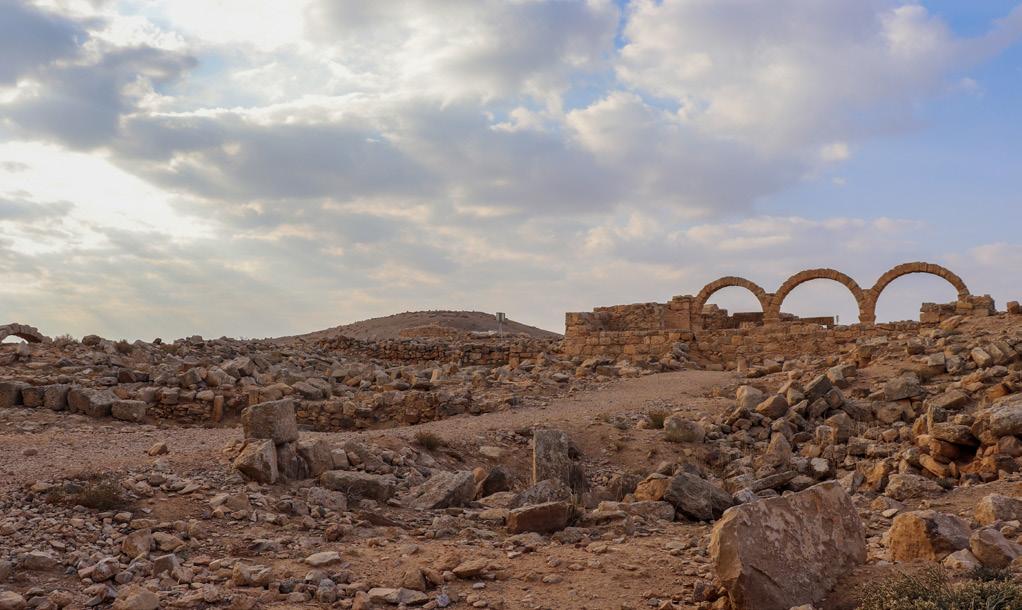
The well-excavated church ruins and spectacular mosaics at Umm al-Rasas are true sights to behold. Inhabited since the Iron Age and mentioned in the Old and New Testaments, the Romans once used the land here as a military outpost before fortifying the city with a large wall. It then became one of the strongholds that formed the Limes Arabicus, a desert frontier created to protect the southeastern part of the Roman Empire from the Sassanid Empire and troublesome raiders. A UNESCO-listed Roman and Byzantine gem, the mosaics of the churches here boast fine depictions of the nearby principal cities and offer clues about this region from centuries ago. Don’t miss the mosaic flooring in the Church of St Stephen, the largest of its kind in Jordan, and just pause here to imagine how many people have traipsed over this spectacular marvel before us.
“ Most enjoyable - the tour gave an insight into the many different influences on Jordanian cultural history.”
YOUR COMPREHENSIVE EXPERT GUIDED TOUR INCLUDES
Expert Guide Lecturer & Professional Tour Manager, entries to all sites as per the itinerary, field notes, all taxes & gratuities to local staff (drivers, waiters, site custodians)
Return flights from London Gatwick, private group transfers to/from the airport and hotel and all local transport aboard a private air-conditioned coach | 4 nights' in the Lamaraz Hotels, Algiers, 1 night in the Sheraton Annaba Hotel, Annaba, 2 nights' at a hotel in Constantine, 1 night in the Park Mall Hotel & Conference Center, Setif, 1 night in the Trajan Hotel, Batna, and 1 night in the Vescera Hotel, Biskra | 10 breakfasts, 9 lunches & 10 dinners | Water with all meals, tea or coffee with dinner
Dates & prices per person based on Twin/Dbl share
23rd Mar - 1st Apr £4,580 £4,295
Single Supplement £810
19th - 28th Oct £4,580 £4,295
Single Supplement £810
Save £285pp with our 2026 Special Offer

Tunisia has some of the finest and best-preserved Roman cities in the world. Many retain the romance of ruins in the countryside, unnoticed and unspoiled by mass tourism. Starting with Carthage and the early Punic colonies, we travel south through ruined towns of the high Roman Empire, where impressive public monuments and houses decorated with brightly coloured mosaics bear witness to the wealth once enjoyed here. We also see the highlights of Islamic culture in Kairouan before continuing to the landscapes of the salt chotts, palm oases and dunes of the south where some remarkable architecture shows how people adapted to conditions at the edge of the desert.
“Delenda est Carthago,” cried Cato, the Elder to the Senate of Rome – "Carthage must be destroyed!”
This phrase emphasised the Roman determination to eliminate Carthage as a rival power. The two cities clashed in a series of conflicts known as the Punic Wars, the most famous of these conflicts was the Second Punic War, where the Carthaginian general Hannibal famously crossed the Alps with his war elephants to invade Italy.
Ultimately, Rome emerged victorious, leading to the destruction of Carthage in 146 BC. Despite its fall, Carthage's legacy lived on, influencing Roman culture and later becoming an important centre in the Roman Empire. Today, the ruins of Carthage are a UNESCO World Heritage site.
The Byrsa Hill site in Carthage is a historically significant location. It served as the citadel of ancient Carthage, offering a strategic vantage point over the surrounding area. This site is renowned for its archaeological importance, providing insights into the Punic and Roman periods of the city's history. Visitors to Byrsa Hill can explore the remnants of ancient fortifications, residential areas and public buildings, making it a must-visit for history enthusiasts.
The Antonine Baths are among the largest Roman bath complexes in Africa. The complex features various rooms, including the frigidarium (cold room), tepidarium (warm room), and caldarium (hot room), each designed to provide a unique bathing experience. The grandeur of the architecture, with its impressive columns and intricate mosaics, highlights the advanced engineering skills of the Romans.

Tony O'Connor | A specialist in the Roman Empire, Tony has excavated widely across Britain, Europe and North Africa. He first led a tour for Andante over 10 years ago and he just gets better and better! Join Tony on our 9th February departure.

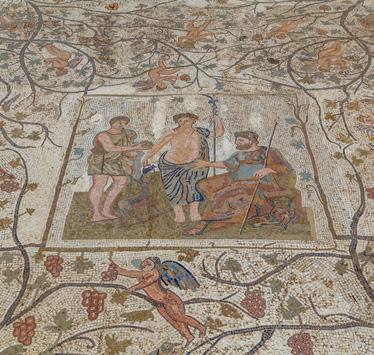
Dr Jamie Sewell | An author of books and articles on the archaeology of towns in Hellenistic Italy, Jamie has 15 years’ worth of experience supervising excavations in Britain, Germany, Italy and Romania. Join Jamie on our 11th November departure.

YOUR TOUR ITINERARY
Day 1 - London - Tunis
Day 2 - Carthage
Day 3 - Tunis – Teboursouk
Day 4 - Dougga - Kairouan
Day 5 - Makhtar – Kairouan
Day 6 - Kairouan
Day 7 - Kairouan - Tozeur
Day 8 - Tozeur
Day 9 - Tozeur - Douz
Day 10 - Douz & Matmata
Day 11 - El Djem – Sousse
Day 12 - Kerkouane – Nabeul
Day 13 - Oudna – Thuburbo Majus
Day 14 - Carthage – Tunis
Day 15 - Tunis - London
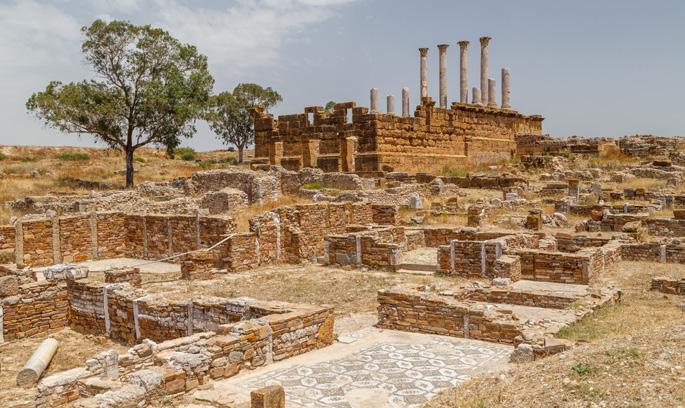
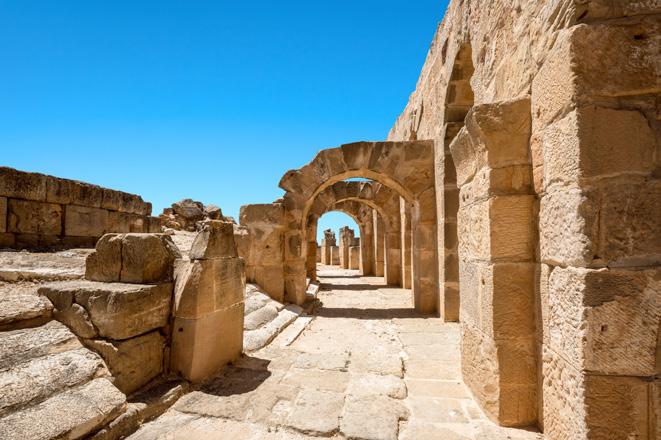
Oudna and Thuburbo Majus are two of Tunisia's most intriguing archaeological sites. Oudna, once known as Uthina, was a prominent Roman city and today boasts well-preserved ruins, including an impressive amphitheatre, a capitol and luxurious Roman villas. The site offers a glimpse into the grandeur of Roman architecture and urban planning.
Thuburbo Majus is another ancient Roman city renowned for its monumental ruins. Located approximately 60 kilometres southwest of Tunis, Thuburbo Majus was a thriving agricultural and trading centre. Visitors can marvel at the remains of the Capitol, the Forum, the Temple of Mercury and the sprawling bath complex. The intricate mosaics and architectural details provide a vivid picture of life in Roman North Africa.
This tour not only delves into the historical significance of these sites but also offers an opportunity to appreciate the scenic landscapes of the Tunisian countryside. Whether you're a history enthusiast or simply looking to experience the rich cultural heritage of Tunisia, the journey from Oudna to Thuburbo Majus promises to be an unforgettable experience.

Located in northwestern Tunisia, the ancient city of Bulla Regia provides a fascinating insight into Roman urban planning along with many treasures to uncover. This rare site contains complete, superbly preserved, subterranean Roman houses, designed to keep the inhabitants cool in the heat of the summer, along with an amphitheatre, baths and temples. Most of the intricate mosaics remain in situ and therefore can be viewed in their original context. In antiquity, the city acquired a notorious reputation and in the 4th century, St. Augustine preached a famous sermon here, berating the citizens for their loose and immoral ways.
“ As good as any of our past Andante experiences. Guide Lecturer, Tour Manager, Local Guide and Driver were all of the highest standard. They ceaselessly gave of their best and took care of us all, entertained, shared their knowledge and nothing was too much for them.”
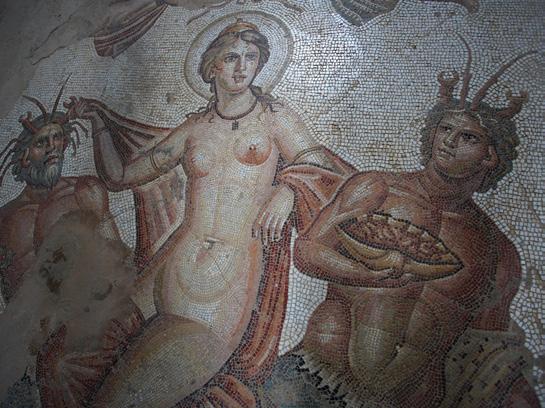
Although most of the archaeological remains are situated in the fertile regions of the north, the Romans did not leave the south unexplored. There are records of military expeditions into the Sahara Desert and a series of fortlets, outposts and towers have been identified to form a frontier intended to control the transhumant movements and trade of desert tribes.
Gafsa is a large oasis town and industrial centre for the phosphates collected from the Chotts of El Jarid. It was once a Numidian town later occupied by the Romans (ancient name Capsa) and guarded the whole of this region until the Arab troops of Okba-Ibn-Naffa seized it in 668. See here one of the remaining ‘Roman pools’, a deep open-air basin fed by hot water springs and visit the small museum opposite.
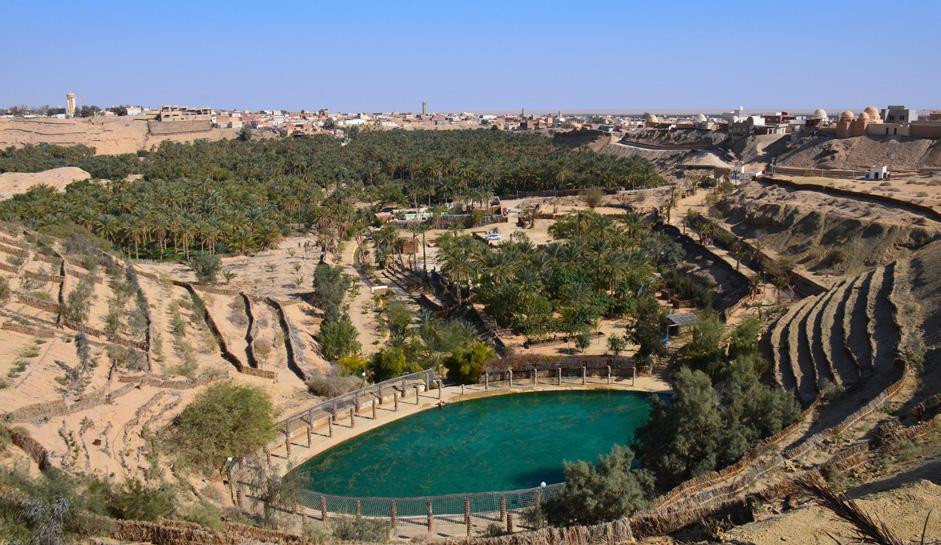

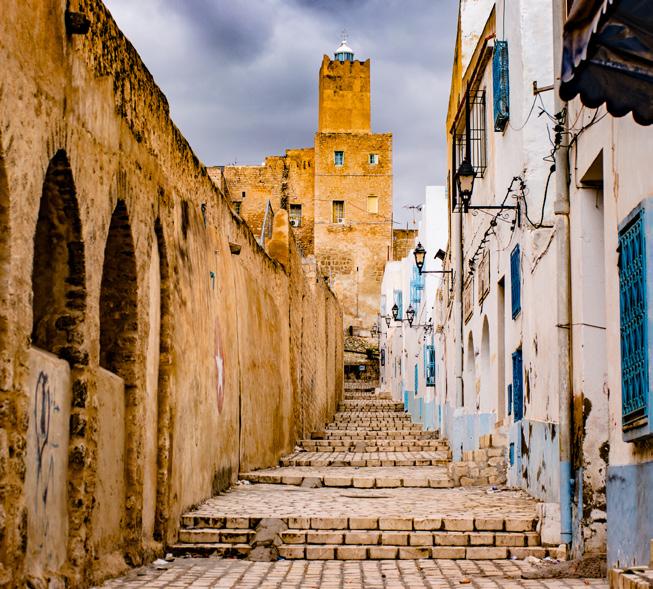
This vibrant city of Sousse is a busy tourist destination but once was an early trading post on the route from Tyre to the West. Often referred to as the "Pearl of the Sahel," Sousse boasts a medina that is a UNESCO World Heritage site, filled with narrow winding streets and historical landmarks.
It was the port used by Hannibal in his campaign against Scipio at the end of the Second Punic War and also by Caesar in 47 BC. The Museum is housed in part of the Kasbah, or high citadel, and the displays include an exceptionally fine series of mosaics from Sousse and the surrounding region. Many are arranged on the floors and walls of the patio and in a group of rooms beyond the garden. We continue to the coast and our overnight hotel near Hammamet.
El Djem is renowned for its impressive Roman amphitheatre, the sixth largest in the world. It had three tiers of seats, to accommodate 30,000 spectators, with further standing room. The huge structure reflects the great wealth of the region, which was founded on its extensive olive groves. It was likely built as a symbol of Rome’s strength, at a time when troubles were besetting the Empire. Afterwards, we visit the museum which houses some of the most impressive mosaics in Tunisia and outside in the museum gardens, the foundations of some large Roman townhouses some with mosaics still in situ.
YOUR COMPREHENSIVE EXPERT GUIDED TOUR INCLUDES
Expert Guide Lecturer & Professional Tour Manager, entries to all sites as per the itinerary, field notes, all taxes & gratuities to local staff (drivers, waiters, site custodians)
Return flights from London Heathrow, private group transfers to/from the airport and hotel and all local transport aboard a private air-conditioned coach | 4 nights' in The Residence Tunis, 2 nights' in the Hôtel Thugga, Teboursouk, 2 nights' in the Hotel La Kasbah Kairouan, 2 nights' in the Dar orchani, Tozeur, 1 night in the The Residence Douz By Cenizaro, Douz, 1 night in the Les Oliviers Palace, Sfax, and 2 nights' in The Sinbad Hotel, Hammamet | 14 breakfasts, 13 lunches & 14 dinners | Water with all meals, wine & tea or coffee with dinner
Dates & prices
per person based on Twin/Dbl share
9th - 23rd Feb £4,790 £4,490
Single Supplement £850
11th - 25th Nov £5,040 £4,725
Single Supplement £895
Save up to £315pp with our 2026 Special Offer
Stand before the mighty ancient amphitheatre of El Djem
10 days from £3,465pp

A land where dramatic events shaped ancient history – the superpowers of Carthage and Rome clashed in three Punic Wars, which determined the course of Western history. Lasting over 100 years, this conflict resulted in the destruction of Carthage and assured Roman ascendancy. Superb sites and changing landscapes, from rolling hills and olive groves to sparkling sea, makes this an excellent tour.
As the Phoenician cities of Tyre, Byblos and Sidon became absorbed by the Assyrian and Persian Empires, Carthage became the ‘new capital’ of the West, at the head of its own trading empire. This fabled kingdom of Dido and her faithless lover Aeneas was the power that Rome sought to emulate and finally destroy in the third Punic War. High on the Byrsa Hill we find a tiny section of what once was – the ruins of Punic houses, parts of the street network and the necropolis, now a UNESCO World Heritage site.

Farès K Moussa | Specialising in religious art and artistic practice, Farès has both written and researched on Romans and Phoenicians in Tunisia, Libya, Morocco and Sardinia, as well as on the subject of prehistoric rock art. Join Farès on our 14th April departure.

Tony O'Connor | A specialist in the Roman Empire, Tony has excavated widely across Britain, Europe and North Africa. He first led a tour for Andante over 10 years ago and he just gets better and better! Join Tony on our 22nd October departure.

YOUR TOUR ITINERARY
Day 1 - London - Tunis
Day 2 - Carthage
Day 3 - Tunis
Day 4 - Tunis - Dougga
Day 5 - Bulla Regia
Day 6 - Dougga - Kairouan
Day 7 - El Djem
Day 8 - Kairouan - Hammamet
Day 9 - Kerkouane
Day 10 - Hammamet - Tunis - London

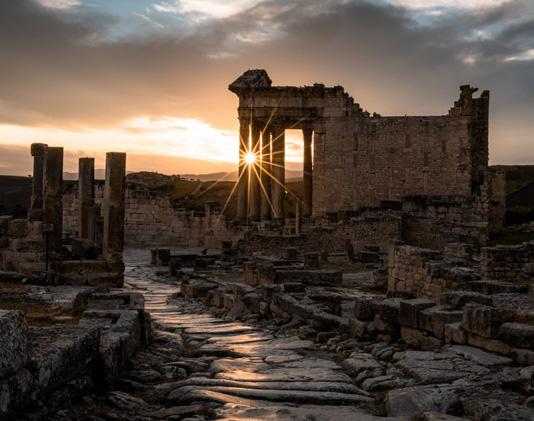
Dougga is one of the oldest towns in Tunisia beginning life as a Numidian walled citadel which was later built over by the Romans. Its native ancestry and hillside location resulted in a winding street plan, rather than a typical Roman grid. One of Tunisia’s World Heritage sites, the town contains many stunning sites, including a beautifully preserved temple, dedicated to the three Roman Gods Jupiter, Juno and Minerva and the giant statues of the gods can be seen today.
Eel Djem was prosperous in the 2nd century AD and into the late antique period when it was an olive oil production centre during the Roman era. On the back of this wealth, the city built several amphitheatres, the most important of which was built in the 3rd century AD and like Rome’s Colosseum, was used for various public events, such as gladiatorial games. It still stands today, as Africa’s largest and best-preserved amphitheatre. The Colosseum is impressive but less well known is the city's fabulous collection of Roman mosaics which rival those we also see at the Bardo.

A UNESCO listed site overlooking the sea, Kerkouane was inhabited from the 7th to 3rd century BC and abandoned after the first Punic War. The town was never reoccupied by the invading Romans, making it the only purely Punic site in Africa.
YOUR COMPREHENSIVE EXPERT GUIDED TOUR INCLUDES
Expert Guide Lecturer & Professional Tour Manager, entries to all sites as per the itinerary, field notes, all taxes & gratuities to local staff (drivers, waiters, site custodians)
Return flights from London Gatwick, private group transfers to/from the airport and hotel and all local transport aboard a private air-conditioned coach | 3 nights' in The Residence Tunis, 2 nights' in the Hôtel Thugga, Teboursouk, 2 nights' in the Hotel La Kasbah Kairouan, and 2 nights' in The Sinbad Hotel, Hammamet | 8 breakfasts, 7 lunches & 8 dinners | Water with all meals, wine & tea or coffee with dinner
Dates & prices per person based on Twin/Dbl share
14th - 23rd Apr £3,695 £3,465
Single Supplement £475
22nd - 31st Oct £3,695 £3,465
Single Supplement £475
Save £230pp with our 2026 Special Offer
“The best holiday that I have ever had in terms of organization, interest and enjoyment.”
Christopher Spring, September 2025

If you are interested in joining one of our tours and want to know more, please do give our Specialist Travel Executives a call today. They are ready to help with all of your questions.


